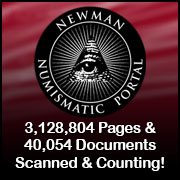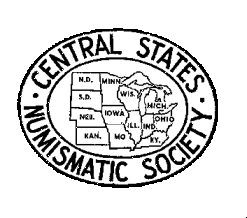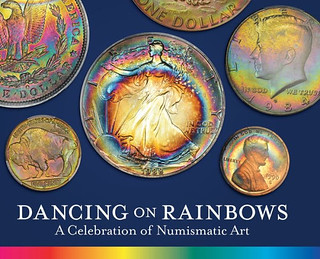
About UsThe Numismatic Bibliomania Society is a non-profit association devoted to the study and enjoyment of numismatic literature. For more information please see our web site at coinbooks.org SubscriptionsThose wishing to become new E-Sylum subscribers (or wishing to Unsubscribe) can go to the following web page link MembershipThere is a membership application available on the web site Membership Application To join, print the application and return it with your check to the address printed on the application. Print/Digital membership is $40 to addresses in the U.S., and $60 elsewhere. A digital-only membership is available for $25. For those without web access, write to: Charles Heck, Treasurer AsylumFor Asylum mailing address changes and other membership questions, contact Chuck at this email address: treasurer@coinbooks.org SubmissionsTo submit items for publication in The E-Sylum, write to the Editor at this address: whomren@gmail.com BUY THE BOOK BEFORE THE COINSale Calendar |
- WAYNE'S WORDS: THE E-SYLUM JUNE 10, 2020
- ROSENBLUM'S NUMISMATIC LITERATURE MINILIST
- NEW BOOK: ENGRAVED GEMS AND PROPAGANDA
- WEB SITE: SASKATCHEWAN MERCHANT TRADE TOKENS
- NUMISMATIC BIBLIOGRAPHY OF ROMAN AQUILEIA
- ANA ELEARNING ACADEMY ANNOUNCED
- VIDEOS: SECRET COIN DESIGNS
- VIDEO: FINANCE MUSEUM OUT OF THE VAULT, PART 2
- THE 1864 JOHN ALLAN SALE
- VIDEO: WALTER BREEN INTERVIEWED
- HERITAGE MOVES TO NEW DALLAS HEADQUARTERS
- AUSTRALIA VIEW: CRELLIN ON PANDEMIC MARKETS
- US VIEW: FEIGENBAUM ON PANDEMIC MARKETS
- CORONAVIRUS UPDATES: JUNE 7, 2020
- MORE MACERATED CURRENCY SOUVENIRS
- MORE ON THE BIRMINGHAM ASSAY OFFICE LIBRARY SALE
- CHARLES I AND THE ROYAL TOUCH
- NOTES FROM E-SYLUM READERS: JUNE 7, 2020
- THE NASBY CUP
- VOCABULARY TERM: MEDAL
- HERBERT E. ROWOLD (1898-1955)
- HARVEY STACK'S NUMISMATIC FAMILY, PART 71
- THE QUINT MINT
- MORE DAVISSON'S E-AUCTION 35 SELECTIONS
- STACK'S BOWERS FRANCESCA SALE SELECTIONS
- STACK'S BOWERS MONTANA TOKEN SALE SELECTIONS
- NUMISMAGRAM MEDAL SELECTIONS: JUNE 2020
- WAYNE'S NUMISMATIC DIARY: JUNE 7, 2020
- A 1929 ST. GAUDENS DOUBLE EAGLE
- ANTI-COUNTERFEITING UPDATE
- ASSAY COMMISSION MEDALS
- THE MEDALLIC ARTISTRY OF ERIK LINDBERG
- MORE ON CIVIL WAR ALLOTMENT CHECKS
- TRAVERSE DOLLARS
- THE DUELING DUAL BANKNOTES OF LIBYA
- COUNTERFEITS IN MILWAUKEE AND MINNEAPOLIS
- CAMBODIA PLANS TO LIMIT U.S. SMALL NOTE USE
- MONEY, BANKING AND DOUBLE-ENTRY BOOKKEEPING
- WHY STAMP COLLECTING IS BACK IN VOGUE
- WEIRD THINGS PEOPLE COLLECT
- LOOSE CHANGE: JUNE 7, 2020
Click here to access the complete archive
To comment or submit articles, reply to whomren@gmail.com
Content presented in The E-Sylum is not necessarily researched or independently fact-checked, and views expressed do not necessarily represent those of the Numismatic Bibliomania Society.
WAYNE'S WORDS: THE E-SYLUM JUNE 10, 2020
 This week we open with Bill Rosenblum's book list, one new book, a new token web site, a bibliography and the ANA's new eLearning Academy.
This week we open with Bill Rosenblum's book list, one new book, a new token web site, a bibliography and the ANA's new eLearning Academy.
Other topics this week include the new Heritage Auction headquarters, the coin market, medals, John Allan, Walter Breen, auction lot previews, Traverse Dollars, the Quint Mint, and Weird Things People Collect.
To learn more about engraved gems, the coinage of Roman Aquileia, CAC and its "Green Beans", Secret Coin Designs, the Columbian Order medal, macerated currency souvenirs, the Birmingham Assay Office library sale, custom slab labels, the amazing Nasby Cup, Bryan Money, the Charles Darwin medal, the six-Foot hypotenuse, and the dueling banknotes of Libya, read on. Have a great week, everyone!
Wayne Homren
Editor, The E-Sylum
ROSENBLUM'S NUMISMATIC LITERATURE MINILIST
Bill Rosenblum of Littleton, Colorado has published a price list of numismatic literature. -Editor

Rita has been bugging me since we moved almost 6 years ago to reduce the size of our library and to sell some of the books that are packed in cartons throughout our office and house. With this list we are attempting to do so. We hope to have a book list at least once a month.
Shipping is extra on all books. Please figure $5 for the first book and $3 for each additional book. Books will be sent Media Mail unless Priority Mail (more expensive) is requested. Shipping rates are for US orders only. Shipping books to other countries has become very expensive and in many cases the shipping overseas will be more expensive than the book itself.
When books are not new we have tried to describe the condition to the best of our ability. We will at times use numismatic grading terms, not book grading terms, to describe the condition of the books. No photos for this list although if you need a scan of the cover we will try to provide it.
To read the complete list, see:
Minilist 15 - June 3, 2013:
Numismatic Books
(http://rosenblumcoins.com/minilist15)
NEW BOOK: ENGRAVED GEMS AND PROPAGANDA
Engraved gems are closely related to numismatics. Pawel Golyzniak has published a new book on the topic. Here's the description from the publisher's web site. I was alerted to the book by a CoinsWeekly article (linked below). -Editor
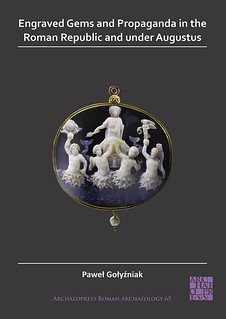 Engraved Gems and Propaganda in the Roman Republic and under Augustus
Engraved Gems and Propaganda in the Roman Republic and under Augustus
Author: Pawel Golyzniak.
Hardback; 618 pages;
fully illustrated catalogue containing 1,015 figures (in colour).
2020
Archaeopress Roman Archaeology 65.
Available both in print and Open Access.
Printed ISBN 9781789695397.
Epublication ISBN 9781789695403.
Engraved Gems and Propaganda in the Roman Republic and under Augustus deals with small, but highly captivating and stimulating artwork – engraved gemstones. Although in antiquity intaglios and cameos had multiple applications (seals, jewellery or amulets), the images engraved upon them are snapshots of people's beliefs, ideologies, and everyday occupations. They cast light on the self-advertising and propaganda actions performed by Roman political leaders, especially Octavian/Augustus, their factions and other people engaged in the politics and social life of the past.
Gems can show both general trends (the specific showpieces like State Cameos) as well as the individual and private acts of being involved in politics and social affairs, mainly through a subtle display of political allegiances, since they were objects of strictly personal use. They enable us to analyse and learn about Roman propaganda and various social behaviours from a completely different angle than coins, sculpture or literature.
The miniaturism of ancient gems is in inverse proportion to their cultural significance. This book presents an evolutionary model of the use of engraved gems from self-presentation (3rd-2nd century BC) to personal branding and propaganda purposes in the Roman Republic and under Augustus (until 14 AD). The specific characteristics of engraved gems, their strictly private character and the whole array of devices appearing on them are examined in respect to their potential propagandistic value and usefulness in social life.
The wide scope of this analysis provides a comprehensive picture covering many aspects of Roman propaganda and a critical survey of the overinterpretations of this term in regard to the glyptic art. The aim is the incorporation of this class of archaeological artefacts into the well-established studies of Roman propaganda, as well as the Roman society in general, brought about by discussion of the interconnections with ancient literary sources as well as other categories of Roman art and craftsmanship, notably coins but also sculpture and relief.
About the Author
Pawel Golyzniak works as a Research Fellow in the Institute of Archaeology, Jagiellonian University in Krakow. His research interests include engraved gems (ancient and neo-classical), Roman Republican and Augustan numismatics, history of antiquarianism, collecting and scholarship as well as 18th century drawings of intaglios and cameos and the legacy of antiquary and connoisseur Philipp von Stosch (1691-1757).

For more information, or to download, see:
Engraved Gems and Propaganda in the Roman Republic and under Augustus
(http://archaeopress.com/ArchaeopressShop/Public/displayProductDetail.asp?id={F81E84A2-AEA8-4EBF-A141-8E57469A3E07})
To read the CoinsWeekly article, see:
Engraved Gems and Propaganda in the Roman World
(https://coinsweekly.com/engraved-gems-and-propaganda-in-the-roman-world/)
To read the earlier E-Sylum articles, see:
NEW BOOK: ANCIENT ENGRAVED GEMS
(https://www.coinbooks.org/v21/esylum_v21n13a06.html)
ANCIENT GEMS AND THEIR CONNECTION TO COINS
(https://www.coinbooks.org/v23/esylum_v23n08a21.html)
WEB SITE: SASKATCHEWAN MERCHANT TRADE TOKENS
John Mutch passed along this notice of a new online catalog of Saskatchewan Merchant Trade Tokens. Thanks. -Editor
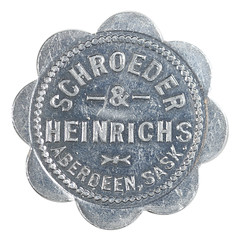
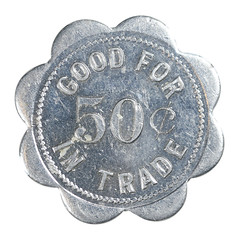
On Facebook Jim MacKenzie wrote:
"My online catalogue of Saskatchewan Merchant Trade Tokens is fully published and ready for public consumption. These pages contain all of the tokens which can be found in the following publications:
- "Trade Tokens of Saskatchewan And Their History" catalogue which was written by Cecil Tannahill and originally published in 1967.
- The tokens section of "An Illustrated Edition On Banking, Trade Tokens, Paper Money & Scrip", also written by Cecil Tannahill and published in 1980.
- The "2014 Checklist Of Saskatchewan Trade Tokens" by Ronald L. Rogal, which was published in 2014, and an update page which was printed in 2015.
- A large number of new finds which have been sent to Mr. Rogal by a number of token collectors"
To read the catalogue online, see:
http://www.saskatooncoinclub.ca/articles/98_sask_merch_tokens_intro.html
NUMISMATIC BIBLIOGRAPHY OF ROMAN AQUILEIA
Riccardo Paolucci submitted this bibliography on the coinage of Roman Aquileia. Thank you. -Editor
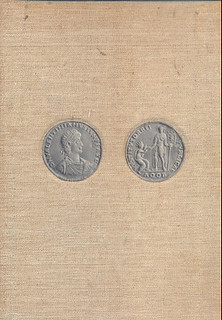 Aquileia was born as a Roman military base, first to expand to Italy and later to Istria and Dalmatia. There are also economic reasons, first against Norico, who was the main form of gold and amber, and then against Pannonia. This made Aquileia an important transport hub for Gaul from west to east to the Alps and later the capital of the 10th region Venetia et Histria (name attributed to the most reluctant population groups) Romanization - the Istri - and the Venetian civilization, who have contributed more than others to give the Italian Ostraum a cultural order.
Aquileia was born as a Roman military base, first to expand to Italy and later to Istria and Dalmatia. There are also economic reasons, first against Norico, who was the main form of gold and amber, and then against Pannonia. This made Aquileia an important transport hub for Gaul from west to east to the Alps and later the capital of the 10th region Venetia et Histria (name attributed to the most reluctant population groups) Romanization - the Istri - and the Venetian civilization, who have contributed more than others to give the Italian Ostraum a cultural order.
The Aquileia crisis prevailed through the devastation of Attila, which occupied it and was destroyed on July 18, 452. They had to escape a future through the city Rebuild Grado. As for the bibliography on the Roman coinage of Aquileia, it was never very extensive, on the contrary, it is very small, especially when we consider the works with the term "Aquileia" in the title.
We know that Maurice Jules began studying French at the beginning of the last century. L’atelier monétaire d’Aquilée pendant la période constantinienne. Milano, 1901. Paperback, s. 42, tab. 1. Very rare and coveted issue among the bibliophiles of the Roman Aquileia coin.
A good leap of just over twenty years and we come to a German-language study that was published in 1923 in the numismatic magazine "Voetter O. Romische Munzpragung in Aquileia". Numismatic Journal, Vienna, 1923.
A good impetus for the study of Roman coinage from Aquileia was in the 1930s and 1940s with three studies by Oscar Ulrich Bansa, the most productive author for Roman Aquileia, Ulrich Bansa Oscar.


Cinque nuove monete di Aquileia romana. Aquileia, s.d. Paperback, s. 42, tab. 2. Ulrich Bansa Oscar. Note sulla zecca di Aquileia Romana. I multipli del soldo d'oro. Grafiche Chiesa, Udine, 1936s. 79, all canvas with 2 photographic pictures on the front (front and back of a coin), 1 tab. folded from the text + 6 tables from the text of coins collected in a special carpet at the end of the volume.
Ratto Rodolfo. Qualche considerazione sulla zecca di Aquileia. Rivista numismatica e Scienze affini 1937;
Grafica Perugia, 1937. Ulrich Bansa Oscar, Le ultime monete della zecca di Aquileia romana. Brossura, Padova 1947 p. 12, tab. 1.
Then the silence apart from a few small articles in some magazines like Leogrande, Aquileia romana, Italia Numismatica, Casteldario and a few studies by Giulio Bernardi e Giancarlo Drioli on a couple of yearbooks by Circolo Numismatico Triestino in the 70s.
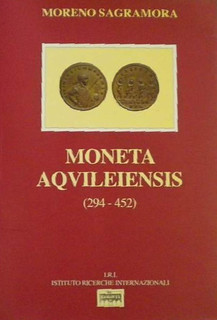
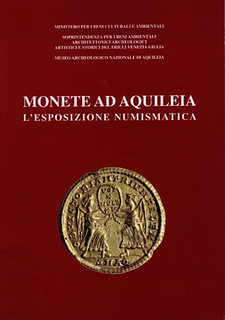
Still a long time of silence to get there Sagramora Moreno. Moneta aquileiensis. I.R.I., Zero Branco, I ed. 1995, 464 s., Ill. and an II edition from 2010. At the end of the last century, Bernardelli Armando, Gorini Giovanni & Saccocci Andrea came out on the occasion of an exhibition. Monete ad Aquileia: l'esposizione numismatica. Ministero beni culturali ambientali, Sovrintendenza Friuli-Venezia Giulia, Museo archeologico nazionale di Aquileia. Edizioni della Laguna; 1997 p. 46.
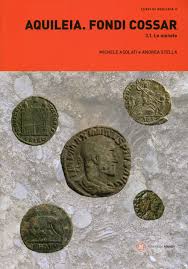

It was only with the new century that the masterly work of Paolucci Raffaele & Zub Artur finally came. La Monetazione di Aquileia Romana. Raffaele Paolucci editore, Padova, 2000s. 259, ill. It was released last year by Asolati Michele & Stella Andrea. Aquileia. Fondi Cossar. 3.1. le monete. Quasar editore, Roma, 2019 p. 292, ill. This volume contains the catalog and the analysis of the money found from archaeological research carried out between 2009 and 2015 by the University of Padua with funds from the former Cossar di Aquileia. The study contains a first part, which deals with the numismatic analysis of individual monetary findings with regard to the archaeological context of relevance. The following is a second part, dedicated to the nest of over 560 late Roman bronze coins found during the 2011 campaign, as well as a summary of the money in circulation in the Italian diocese during the 5th century AD, aimed at finding the finds the aquile eggs from this period.
Everything here is the specialist bibliography on Roman Aquileia. There are other works dealing with the coin of Aquileia, mainly we have 4 volumes of the Roman Reich coinage of the Bible for Roman Reich coins. Bruun Patrick Magnus. The Roman Imperial Coinage vol. VII. London, 1966. Kent J.P.C. The Roman Imperial Coinage vol. VIII. London, 1981. Pearce J.W.E. The Roman Imperial Coinage vol. IX. London, 1951. Kent J.P.C. The Roman Imperial Coinage vol. X. London, 1994 Bastien, Depeyrot and Jelocnik also deal with the Roman Aquileia coin and, however, in volumes that deal with Imperial Roman numismatics in general and not specifically with the coin we are talking about.
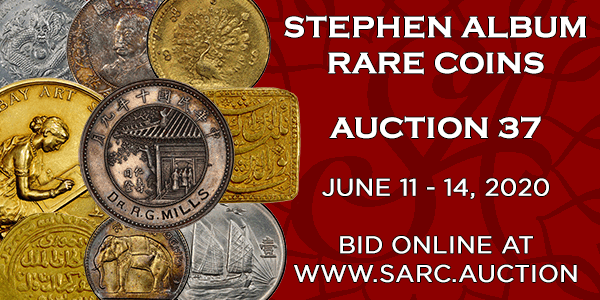
ANA ELEARNING ACADEMY ANNOUNCED
The ANA has announced their new eLearning Academy, beginning with online versions of Summer Seminar classes. -Editor
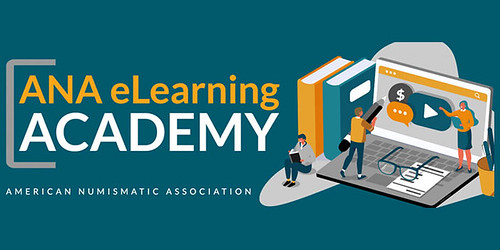
Provides Taste of Summer Seminar
Collectors Can Register for Free Condensed Courses
During what would have been the American Numismatic Association's (ANA) annual Summer Seminar event – June 29-July 10, the Association will instead offer free virtual courses through its new ANA eLearning Academy. Eleven courses that would have been offered during the week-long Summer Seminar will be offered in a condensed one- to two-hour online format. Courses are open to both ANA members and non-members; there is no charge to participate but preregistration is required.
Summer Seminar is a once-a-year opportunity that offers collectors a varied selection of week-long courses designed for discovery or continued study. COVID-19 forced the cancellation of the 2020 event – the first time in the program's 50-plus year history. Although these online classes are not a replacement for Summer Seminar, they provide a sampling of select courses offered during the popular summer event. ANA eLearning Academy courses during this block include:
Two-hour classes —
• Grading 101 (June 30, 11 a.m. MDT)
• Detection of Counterfeit and Altered Coins (July 2, 12 p.m. MDT)
• Introduction to Early U.S. Paper Currency: 1765-1865 (July 6, 12 p.m. MDT)
• Understanding the Art of Rare Coin Submissions (July 6, 2:30 p.m.)
• The Modern Minting Process: Errors and Varieties (July 7, 12 p.m. MDT)
• Collecting and Investing in Morgan Dollars: A Comprehensive Approach (July 8, 12 p.m. MDT)
• Mexican Voices in Metal and Paper (July 9, 1 p.m. MDT)
One-hour classes —
• Young Collectors Panel (June 29, 12:30 p.m. MDT)
• CAC and its "Green Beans" (July 1, 1 p.m. MDT)
• Italian Numismatics: Insights Through Modern History (July 3, 10 a.m. MDT)
• Creating a Great Club Newsletter (July 10, 11 a.m. MDT)
After this first round of courses, the ANA eLearning Academy will continue to offer two to three classes each month to the collecting community. Class topics are designed to appeal to a range of collectors – from beginners to advanced numismatists.
For detailed class descriptions and to register, visit info.money.org/elearning; or contact Seminars Manager Brianna Victor at (719) 482-9865 or at seminars@money.org for more information.
To read the complete article, see:
New ANA eLearning Academy
Provides Taste of Summer Seminar
(https://www.money.org/uploads/pdfs/press-releases/Press%20Release%20-%20eLearning%20FINAL.pdf)
VIDEOS: SECRET COIN DESIGNS
Michael van den Heuvel of Denmark is the author of World Square Coins 1900-2000. He recently produced a series of YouTube videos on unrealized coin designs. Here's a list and link to his YouTube channel. -Editor
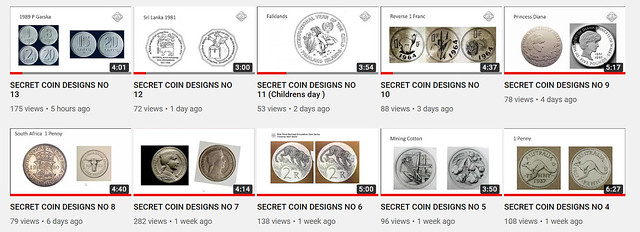
To watch the videos, see:
Square Coin Talk
(https://youtu.be/WkNykpfSf8c)

To read the earlier E-Sylum article, see:
NEW BOOK: WORLD SQUARE COINS 1900-2000
(https://www.coinbooks.org/esylum_v15n50a05.html)
VIDEO: FINANCE MUSEUM OUT OF THE VAULT, PART 2
Last month the Museum of American Finance began a new series of videos highlighting key objects from their collection. Here's the second part. -Editor
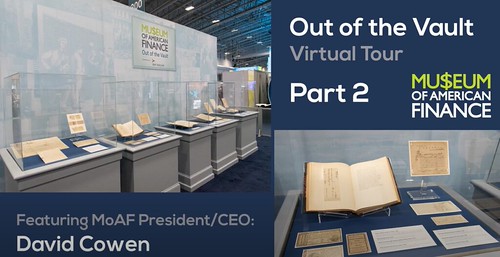
On May 8, the Museum posted the first video in its new “Out of the Vault” video series, which is now available on its YouTube channel and across its social media platforms. These short videos explore objects and documents from the Museum’s collection that were featured in the “Out of the Vault” exhibit. David Cowen, the Museum's president and CEO, narrates the series from his home during the COVID-19 lockdown.
The “Out of the Vault” exhibit showcased some of the most unique, interesting and historical artifacts in the Museum’s collection. Featured objects include some of the nation’s founding financial documents, such as Alexander Hamilton’s Report on the Public Credit—considered to be the economic equivalent of the US Constitution— as well as the 1792 George Washington bond, which was signed by President Washington and is believed to bear the first use of the dollar sign on a US federal document. Many artifacts were signed by American political and business leaders from the 18th century through today, while others highlight technological innovations that transformed the financial services industry. Together, these objects represent more than 225 years of American financial history and achievement.
To watch the video, see:
"Out of the Vault" (Part 2)
(https://www.youtube.com/watch?v=cjLmwJudRqc&feature=youtu.be)
To read the complete article, see:
“Out of the Vault” Video Series Offers Virtual Tour of Museum Collection
(https://www.moaf.org/news/announcements/2020-05-08-out-of-the-vault-video-series-offers-virtual-tour-of-museum-collection)
To read the earlier E-Sylum article, see:
VIDEO: FINANCE MUSEUM OUT OF THE VAULT
(https://www.coinbooks.org/v23/esylum_v23n20a10.html)
THE 1864 JOHN ALLAN SALE
Newman Numismatic Portal Project Coordinator Len Augsburger provided the following discussion based on digitized material at NNP. Thanks. -Editor
Treasures in a 19th Century Antiquarian Sale
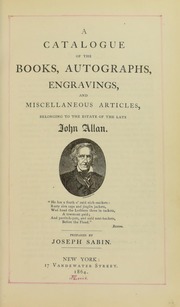 Dave Hirt commented this week about his scanned copy of the John Allan (1864) sale catalog on Newman Portal. As a result we more closely examined the catalog, which contains a few items of note. Newman Portal has two copies of this catalog, one from the Hirt library and the other from the ANS. The ANS copy traces to Allan’s daughter, Margaret Stewart, and includes rich annotations as well as a signed letter from John Allan. The handwritten annotations further refer to numismatic luminaries Lyman Low and Isaac F. Wood. Additionally, someone has marked all of the numismatic portions in blue pencil, which, while perhaps disrespecting the artifact, increases its utility. Several lots are noteworthy:
Dave Hirt commented this week about his scanned copy of the John Allan (1864) sale catalog on Newman Portal. As a result we more closely examined the catalog, which contains a few items of note. Newman Portal has two copies of this catalog, one from the Hirt library and the other from the ANS. The ANS copy traces to Allan’s daughter, Margaret Stewart, and includes rich annotations as well as a signed letter from John Allan. The handwritten annotations further refer to numismatic luminaries Lyman Low and Isaac F. Wood. Additionally, someone has marked all of the numismatic portions in blue pencil, which, while perhaps disrespecting the artifact, increases its utility. Several lots are noteworthy:
 Lot 1426: Hart’s 1851 History of Issues of Paper Money in the American Colonies. This is a legendary rarity of American numismatic literature, with only three plated copies known. The Newman copy (Heritage Auctions, Newman XI, 11/2018, lot 15236) sold for $19,200. This lot description contains the enigmatic clue “The present copy contains a large number of Specimens of Paper Money, issued before and during the Revolutionary war.” So, was it a plated copy, an interleaved copy with mounted examples of currency (similar to the Hamelberg copy of Phillips’ Historical Sketches of Paper Currency of the American Colonies), or simply an unplated copy with a few worn colonial notes laid it? The price realized ($16.00) was strong money for a secondhand book in 1864.
Lot 1426: Hart’s 1851 History of Issues of Paper Money in the American Colonies. This is a legendary rarity of American numismatic literature, with only three plated copies known. The Newman copy (Heritage Auctions, Newman XI, 11/2018, lot 15236) sold for $19,200. This lot description contains the enigmatic clue “The present copy contains a large number of Specimens of Paper Money, issued before and during the Revolutionary war.” So, was it a plated copy, an interleaved copy with mounted examples of currency (similar to the Hamelberg copy of Phillips’ Historical Sketches of Paper Currency of the American Colonies), or simply an unplated copy with a few worn colonial notes laid it? The price realized ($16.00) was strong money for a secondhand book in 1864.
Lot 489: Bushnell’s Historical Account of the First Three Business Tokens issued in the City of New York (1859). Number 22 of 50 plated, large-paper copies, this is a rare if little-known work. The Bass IV copy (Kolbe, June 2010, lot 103) sold for $1,800.
Lot 959: William E. Du Bois’ Pledges of History (1846). One of 140 copies, this is the earliest attempt at a catalog of Mint Cabinet, today the National Numismatic Collection. The Newman copy (Heritage, Newman XI, 11/2018, lot 15205) sold for $600.
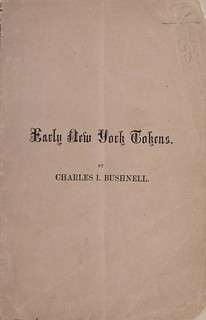

Lot 3442: An autograph letter signed by George Washington, cataloged as “General Washington’s Answer to the Address of the Corporation of New York, conferring upon him the Freedom of the City, dated May 2d, 1785.” This sold for an astonishing $2,050, and the City of New York quickly sued the estate. An annotation in the ANS copy of the catalog summarizes “A suit by the corporation of New York to recover possession of this letter, or its value, Feb. 14th 1866. Jury rendered a verdict in favor of plaintiffs for $2050.” An unattributed clip pasted into the ANS copy of this catalog gives further detail on the suit, including that the defendant cited the statute of limitations, as more than six years had elapsed since the cause of action arose, and that Allan had possession of the letter since at least 1834. Complicating matters was the winning bidder of the lot, De Witt C. Lent, who apparently caught wind of the litigation and refused to pay for the lot. Many parallels with situations of our own time could be cited.

Lot 4300: Silver medal, “COLUMBIAN ORDER. Instituted 1789.” This medal, engraved by John Pearson, reappears in the 1925 W.W.C. Wilson sale, lot 819 (realized $300), there catalogued by Wayte Raymond as “White man, holding flag, clasps hands with Indian smoking calumet, WHERE LIBERTY STANDS THERE IS MY COUNTRY….Snake coiled in foreground….silver shell…” A halftone plate is included, which may explain its absence in the 44 photographic plates present in the Hamelberg copy of this sale. This is an important, early American medal that would be far more popular if only a few additional examples had been struck.
Vicken Yegparian notes that ANS acquired the Allan/Bushnell/Wilson piece (illustrated in the Summer 2009 ANS Magazine), also has an electrotype copy, and further notes the Massachusetts Historical Society has the Appleton piece. Finally, Vicken points to a uniface lead die trial of the Columbus (obverse?) side, from Ford XVI (Stack’s 10/2006, lot 189, ex. F.C.C. Boyd). Yegparian’s research revealed that “Columbian Order” was an alternate name for the Tammany Society, and that this medal served as the members badge of this organization (as did other medals).
Image: COLUMBIAN ORDER medal, from the W.W.C. Wilson sale, 11/1925, lot 819.
Link to Dave Hirt copy of the John Allan (1864) sale:
https://nnp.wustl.edu/library/auctionlots?AucCoId=510292&AuctionId=512856
Link to ANS copy of the Allan sale:
https://nnp.wustl.edu/library/auctionlots?AucCoId=510292&AuctionId=511736
Link to Wayte Raymond’s sale of the W.W.C. Wilson collection:
https://nnp.wustl.edu/library/auctionlots?AucCoId=511546&AuctionId=514190
Link to Hamelberg copy of the W.W.C. Wilson catalog (with 44 photographic plates):
https://archive.org/details/wwcwilsoncollect0000wayt/mode/2up
VIDEO: WALTER BREEN INTERVIEWED
These are selections from the David Lisot Video Library that feature news and personalities from the world of coin collecting. David has been attending coin conventions since 1972 and began videotaping in 1985. The Newman Numismatic Portal now lists all David’s videos on their website at:
https://nnp.wustl.edu/library/multimediadetail/522852
Here's one with numismatic researcher and author Walter Breen. -Editor
PNG Living History: Walter Breen, 8/15/1988
David Lisot, Interviewer.
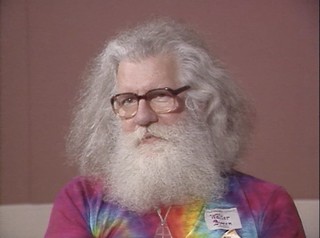 Walter Breen is one of the most enigmatic and controversial characters in all of numismatics. His photographic memory and knowledge of numismatics was legendary. He authored "Walter Breen's Complete Encyclopedia of U.S. and Colonial Coins". He was also a convicted pederast. In this video Walter shares who got him involved in numismatics in 1950. He talks about the state of knowledge in numismatics, modern issues, and what is important in the coin hobby. He shares stories about his mentors Wayte Raymond, John Ford and other others. He philosophize about numismatics. He was interviewed by David Lisot on August 15, 1988 as part of a video series called "Living History" sponsored by the Professional Numismatists Guild.
Walter Breen is one of the most enigmatic and controversial characters in all of numismatics. His photographic memory and knowledge of numismatics was legendary. He authored "Walter Breen's Complete Encyclopedia of U.S. and Colonial Coins". He was also a convicted pederast. In this video Walter shares who got him involved in numismatics in 1950. He talks about the state of knowledge in numismatics, modern issues, and what is important in the coin hobby. He shares stories about his mentors Wayte Raymond, John Ford and other others. He philosophize about numismatics. He was interviewed by David Lisot on August 15, 1988 as part of a video series called "Living History" sponsored by the Professional Numismatists Guild.
An excerpt of the video is available for viewing on the Coin Television YouTube Channel at:
https://youtu.be/UMqJDo2WazY
To read earlier E-Sylum articles, see:
CONFRONTING THE LEGACY OF WALTER BREEN
(https://www.coinbooks.org/esylum_v18n45a11.html)
READER COMMENTS ON WALTER BREEN
(https://www.coinbooks.org/esylum_v18n46a10.html)

HERITAGE MOVES TO NEW DALLAS HEADQUARTERS
Life goes on, even in a pandemic. Heritage Auctions is consolidating its Dallas-area operations in a new headquarters building. Here's the press release. -Editor
Dallas-Based Heritage Auctions Relocates World Headquarters to New, 160,000 Square-Foot Campus
America’s Auction House consolidates three Dallas locations in state-of-the-art facility near DFW Airport
 Heritage Auctions has moved its global headquarters into a new state-of-the-art, 160,000-square foot facility and multi-purpose campus, befitting its status as the largest auction house founded in America.
Heritage Auctions has moved its global headquarters into a new state-of-the-art, 160,000-square foot facility and multi-purpose campus, befitting its status as the largest auction house founded in America.
As of June 1, Heritage Auctions’ global headquarters is now located at 2801 W. Airport Freeway, Dallas, Texas 75261, which is adjacent to Dallas Fort Worth International Airport and in its foreign trade zone. Transwestern Principal Nora Hogan facilitated the move, with additional support from Principal Robert Deptula and Vice President Jordan Wade. Mark Hayes with HPI Real Estate Services and Investments represented the landlord, Bandera Ventures.
The new headquarters, less than 30 minutes from both downtown Dallas and Fort Worth, is twice the size of Heritage’s longtime home at 3500 Maple Avenue, and now consolidates its three separate Dallas locations under a single roof. The single-story complex spans the length of nearly three football fields.
Nearly 450 of Heritage’s more than 600 employees occupy its new headquarters.
In the works for more than a year, this consolidation is the most significant expansion in the firm’s history, and comes at just the right moment.
Heritage is already renown as the world’s largest collectibles auction house – a global leader in coins, comic books, sports and entertainment memorabilia, among 40 categories. In recent years, however, the company has made dramatic and significant expansions into the realms of fine art, fine and rare jewelry and timepieces, luxury handbags, rare wines and historic nature and science artifacts. The move to the expansive new facility will increase operational efficiencies and allow Heritage to better serve its more than 1 million clients, both buyers and consigners from across the globe.
The new headquarters features an 8,000 square foot gallery showroom for invitational art exhibitions and events, such as collectibles shows.
“We are excited to now be in the middle of Dallas-Fort Worth near one of the world’s largest airports,” said CEO and Co-Founder Steve Ivy. “This location and facility will better serve all of our clients, including bidders and consignors who visit our showrooms or consign with us.”
“After reviewing all available options, Heritage Auctions decided to start with a clean slate under one location that still allows for superior worldwide customer service to clients,” said Hogan. “Located at the intersection of two major highways, this space allows Heritage to easily serve out-of-town clients as well as DFW residents who need appraisals. This location also allows them to serve the metroplex while keeping a Dallas address, which is where the company started and is considered an integral part of the Heritage legacy.”
David Stone writes:
"The new Heritage Auctions World Head Quarters will be a state-of-the-art facility that consolidates all of Heritage Auctions’ Dallas operations at a convenient location near DFW airport and the outstanding Irving Convention Center. I am still working at the old location (until next Monday), so I don’t have much personal experience with the new building yet. I am looking forward to many productive years at the new facility."
AUSTRALIA VIEW: CRELLIN ON PANDEMIC MARKETS
Here's a view of today's numismatic market from Down Under by Andrew Crellin of Sterling & Currency in Fremantle, Western Australia, published in his Market News blog June 6, 2020. -Editor

You don't need me to let you know what life has been like since March 12th - that distant bygone date when the World Health Organisation (WHO) officially declared COVID-19 as a pandemic.
Just in Australia, we've had restricted movement not only internationally and interstate but within states and within regions. This has forced many of us to be at home for many, many more hours than we otherwise would have been, and as the Devil is said to find work for idle hands, many of us have turned to our hobbies to keep ourselves occupied and with some sense of forward movement.
As the magnitude of this disease unfolded around the world, and we began to read forecasts of the impact it would and could have on incomes for businesses and individuals, I absolutely expected the economic consequences to be far worse than we've seen so far.
Collectors Without Income or Savings - Forced Sellers
I was concerned we'd see people who were without income and savings being forced to sell items from their collections and wasn't sure just what demand there would be for them from those that happened to be better positioned to cope.
How wrong I was - whether it's due to the Commonwealth Government's JobKeeper program, the better financial health of the general man than I expected or complete indifference to financial ruin, many collectors have been quite content to focus on their collections over the past two and a half months.
Will this activity run out of puff as soon as JobKeeper ends its run? Once the next few credit card statements come in? Or are we going to keep ticking along well into 2021? One thing we do know about markets is that they feed off themselves - as behaviour is reinforced positively with movement upward in prices, market momentum builds over time.
Online Shopping and Payments Facilitates Activity
Online shopping is obviously facilitating this activity, it's a way of keeping busy while remaining isolated at the same time. One interesting nuance of this current situation is the impact that social distancing; concern for health and the prevention of anything-but-local travel is having on the oft-quoted "supply chain" for numismatic items on the secondary market.
It's been some time since I was active in any meaningful way in coins and sets offered directly from Australia's mints, but I expect if I were actively selling them and I sold out, I could replenish my stocks as soon as they ran out, simply by placing an order with the relevant Mint.
The Supply Chain for the Secondary Market - Will It Break Before We Return to "Normal"?
When it comes to products on the secondary market however, re-supply isn't quite as simple. When I know that a customer has a specific coin, note or set that they're no longer beholden with, I know I can contact them with an idea of perhaps selling it or trading it against something else that suits their current collecting patterns more closely. In the absence of that, it is challenging to locate regular supply when the general public and collectors aren't entertaining heading out and about to deal with a relatively complex project such as selling a collection of coins or notes.
I reckon most of us are specifically focused on getting through each day or week at the moment and are waiting for some kind of indication that life is returning to "normal" before we get stuck into anything that requires a good degree of planning and exercise of the grey cells.
One major challenge for someone looking to sell a valuable collection of tangible assets without being able to physically deliver it to a dealer and discuss it in detail is, how do you deliver it and discuss it in detail without leaving yourself open to the risk of loss in transit or having a whole lot of hassle once it has been delivered?
That's a whole other discussion that'll be forthcoming in the coming months, but I've mentioned it because if this situation doesn't change in the coming months, dealers such as myself will find it challenging to replenish their stock by any means! If the conversations I've had with my colleagues that run auction houses are any guide at all, they're in exactly the same position - this means we could see some strong price movement as dealers begin to compete with an already-active cohort of collectors.
The article goes on to discuss in detail pricing for Australian and world numismatics in recent auctions. including sales by Noble, Downie's and Heritage, including a discussion of top-quality examples independently assessed by PCGS. -Editor
To read the complete article, see:
SO HOW HAS THE WORLD PANDEMIC LOCKDOWN AFFECTED THE NUMISMATIC TRADE?
(https://www.sterlingcurrency.com.au/blog/news-research/market-news/so-how-has-the-world-pandemic-lockdown-affected-th/)
US VIEW: FEIGENBAUM ON PANDEMIC MARKETS
John Feigenbaum of CDN Publishing wrote about the current state of the market in his Publishers Message in the June 2020 Greysheet. Here's an excerpt. -Editor
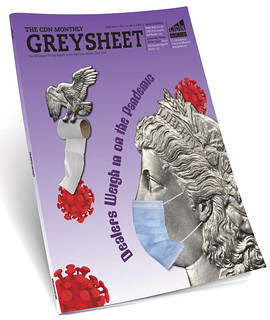 Surely Marriott, United Airlines, and Starbucks could have spent money modeling the potential outcome of such an event—but it appears they didn’t.
Surely Marriott, United Airlines, and Starbucks could have spent money modeling the potential outcome of such an event—but it appears they didn’t.
They were all caught flat-footed which was obvious in the early weeks of the pandemic as we all witnessed a chaotic scramble to maneuver. Even the CDC of all places, was unprepared as early reports from Washington State begged for testing help.
All of which brings me to my point that the early economic affects of the pandemic on business in this country are almost entirely arbitrary. Few were prepared and this disaster is playing out like an F-5 tornado in a small town where some streets get leveled and others are entirely unaffected.
As you will read in Patrick’s Market Report and the dealer quotes in our Featured Editorial, the numismatic hobby has been extremely fortunate to weather this storm. Old-fashioned hobbies like coin collecting are a welcome embrace in a world devoid of live sports where we are forced to stay home most of the day.
Most coin dealers I’ve spoken to are genuinely surprised by how busy they have been during this time. They’re finally cleaning out the backs of their safe because they can’t fly to a coin show every weekend. As John Kraljevich told me, “I stopped bringing $50–$200 tokens and medals to coin shows years ago, so they’ve been accumulating. I started offering them on Instagram (@jkamericana) and they’re flying out of here. I can’t believe how busy I am.”
Here at CDN, I am surprised and blessed to report that our subscription base has only grown during this time. Six months ago we were an anachronistic company publishing printed magazines to an aging audience. Today, we’re fortunate to be one of the few successful publishers in a world that has slowed to a crawl.
It’s not all positive even in the coin business though. Promoters of coin shows are truly struggling as their events are shut down. And the dealers who made a living attending these events are suffering as well. The world will never be the same. When we finally emerge from this dark cloud, our hobby will be altered as well. Hopefully for the better. Stay safe!
To read the complete article, see:
Publishers Message (June 2020 Greysheet)
(https://www.greysheet.com/news/story?title=publishers-message-june-2020-greysheet)
CORONAVIRUS UPDATES: JUNE 7, 2020
Here's the latest compilation of coronavirus updates from readers, organizations and companies -Editor
Central States Eliminates Coin Show Positions (June 1, 2020)
The fallout from cancelled shows and moved auctions continues. As a cost-saving move the Central States Numismatic Society's board of governors has decided not to renew the contracts of their convention general chairman and bourse chairman. -Editor
Faced with a projected deficit in 2021, the board anticipates trimming convention expenses and replacing some paid staffers with volunteers in an attempt to bring the budget into balance.
The Central States anniversary convention, held each April, is one of the nation's larger coin shows, with nearly 300 dealer booths, an expansive exhibit area and notable auctions."
For more information on the Central States Numismatic Society, see:
https://www.centralstatesnumismaticsociety.org/
Mint Directors Conference Postponed (June 3, 2020)

From the announcement:
"Following continuing concerns over the progression of the COVID-19 pandemic and its effect on global travel and large gatherings, the Mint Directors Conference and the South African Mint have decided to further postpone MDC2020 in Cape Town to 31 October to 3 November 2021.
"While they regret the extended postponement, the MDC and SA Mint advised, in a recent statement, that they believe it is the right action to take in the current environment. In particular, they advised the need to consider that social distancing, lockdowns and travel bans are likely to be with us for some time to come, and that this could have resulted in reduced attendance at the conference, at a critical time when optimum representation is needed from the minting community. See full statement.
"All current arrangements for the programme, social events and venue remain the same."
To read the complete article, see:
Postponement of the 2020 Mint Directors Conference
(https://mdc2020southafrica.com/postponement-of-the-2020-mint-directors-conference/)
Stack's Bowers New York Store and Office Reopening (June 4, 2020)
From the announcement:
 "We are happy to announce that our New York City Store and Office will be back in operation starting Monday, June 15. We are still at our temporary location, 1177 Avenue of the Americas, 5th floor Regus Center.
"We are happy to announce that our New York City Store and Office will be back in operation starting Monday, June 15. We are still at our temporary location, 1177 Avenue of the Americas, 5th floor Regus Center.
"Visits are by appointment only. As we can only see one client at a time, please contact us as soon as possible to secure a time slot that is best for you. We will schedule appointments from 10 am to 4 pm, Monday through Friday.
"Stack’s Bowers Galleries is very proud to have been able to serve our clients in creative ways during these unprecedented times. We are grateful that we have been able to assist you with buying, selling or auctioning despite the restrictions. As we ease back into more normal operations, we look forward to an even greater level of personal service.
"Our highest priority is the safety and security of our clients and staff. To that end, we will ensure that social distancing guidelines are followed, and we are preparing our office for this. Masks and gloves will be required to transact business with us for the foreseeable future. Chairs and tables will be sanitized before each client visit. No more than two clients – engaged in the same transaction – will be allowed in the office at any time. We will have plexiglass on the table separating clients from staff."
To read the complete article, see:
Our New York Store and Office Reopening
(https://www.stacksbowers.com/News/Pages/Blogs.aspx?ArticleID=new-york-store-reopening)
Bill Rosenblum's Colorado Report (June 6, 2020)
Bill writes:
"Our local ancient and world coin club (DAWN for Denver Area World Numismatists) has met the last two months via Zoom. Not quite like a real in-person meeting but it's nice to get together with friends and talk about what is happening. If any member of DAWN wants to join our next meeting please email me at Bill@Rosenblumcoins.com by the beginning of July and I'll send out an invitation. Hundreds of people all over the country (and perhaps the world) are life members. We are mostly a very unorganized group and rarely spend any time on club business. The first time you attend you are a guest, after that you become a life member. Bob Hoge joined us from NYC last night.
"While Colorado is beginning to open up a little and many of the restrictions have been lifted large gatherings are still not allowed under the governor's orders. I believe that an update will be issued on June 15th. The Colorado Springs Coin Show is still scheduled for July 1 through 4 although that is still tentative. Ken Byrd who runs the show is hoping that the city of Colorado Springs will grant a variance and the show will go on. The show is usually held between (and overlapping) the sessions of the ANA's Summer Seminar and is always crowded with out of town students and instructors. This year the seminar has been cancelled and because of some health issues I have I recently cancelled my table.
'This show has always had a special place in my heart and I've had a table at the show since the mid-1970s or perhaps even as early as 1972. It was the first show I attended in Colorado after I moved here in 1971. And it was there where I was taught to grade banknotes by ear. "Doc" Klein, who was an eye surgeon from Albuquerque was a fixture at coins shows during the 1960s, 70s and 80s. His relaxation came from setting up at coin shows almost every weekend. I stopped his table and he had a banknote I was interested in. It was marked "crisp" but had a very visible fold down the center. When I pointed this out, he took the note out of the holder and said "listen" as he shook the note. Sounded just like a crisp piece of lettuce."
More Coronavirus Jokes
Here's another selection of coronavirus jokes from the Good Clean Funnies list. See the full article online. -Editor
• Due to the quarantine, I'll only be telling inside jokes.
• I'll tell you a Coronavirus joke, but you'll have to wait two weeks to see if you got it.
• What do you call panic buying of sausage and cheese in Germany? A Wurst Kase scenario.
• The grocery stores in France look like a tornado hit them. All that's left is de brie.
• In my day, you would cough to cover up a fart. Now you fart to cover up a cough.
To read the complete article (or subscribe), see:
Coronavirus One-Liners (Groaners)
(https://gcfl.net/archive.php?funny=8161)
To read the earlier E-Sylum article, see:
CORONAVIRUS UPDATES: MAY 31, 2020
(https://www.coinbooks.org/v23/esylum_v23n22a13.html)

MORE MACERATED CURRENCY SOUVENIRS
Tony Terranova submitted these photos of two macerated currency souvenir items I hadn't seen before. Thanks! -Editor
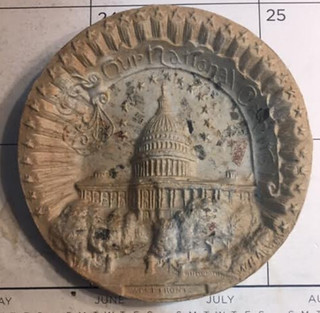

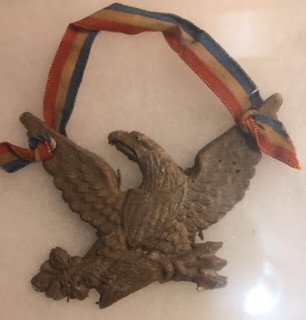
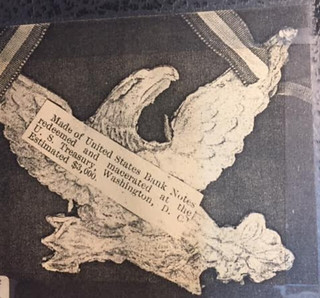
To read the earlier E-Sylum article, see:
NOTES FROM E-SYLUM READERS: MAY 31, 2020 :
Fiber / Masticated Paper / Macerated Paper
(https://www.coinbooks.org/v23/esylum_v23n22a14.html)
MORE ON THE BIRMINGHAM ASSAY OFFICE LIBRARY SALE
Gil Parsons submitted these thoughts on the recent Birmingham Assay Office library sale. Thanks! -Editor

John Andrew's excellent piece on the recent Birmingham Assay Office Sale had much to provoke thought. I just wanted to add some personal reflections as an adjunct to the article. The sale, after having been switched from a high profile venue to an online only format, proved to be one of the very first of any type to happen after the lockdown. My expectation, echoed by that of many colleagues, was that it would be time to buy heavily, in accord with the dictum of Buffett and others: "Buy when there's blood in the streets." This proved, as had been the case with a sale in New York immediately before, totally unrealistic.
I rose at 2:00 AM California time and rapidly discovered that I would spend a fair amount of time sitting on my hands as prices almost across the board climbed far above what any rational dealer might be inclined to pay. The auctioneers refer to such a sale as "a white-glove" sale, ie, one in which every lot sells. I do believe that the sale represents one of those watershed events which will prompt all of us, dealers and collectors alike, to adjust our thinking upwards with regard to values, particularly of items unique or rarely seen in the marketplace. I was not totally dissatisfied, and did manage to purchase a few lots, but my review of the catalogue subsequent to the sale convinced me that I had been excessively timid in the face of changed realities.
As regards John Andrew's larger point: "What does it all have to do with numismatics?" There is much to be said, and I believe that one positive benefit of such a sale is to inculcate the idea that "numismatic literature" might well be a far broader category than has customarily been thought and we can all grasp more widely at issues of context and related matters to further our numismatic understandings. One example might serve: there was an exceptional offering in the Birmingham sale of books on metalwork in general and on ornament in particular, much of which can be brought to bear on the artistic influences upon coin and medal engravers. Likewise, law and banking bear heavily upon numismatic thinking.
OK, I don't fully understand the relevance of books on glass or majolica or especially that of two of the stars of the sale, both Harrison on Longitude (Lot 207 Account of the Proceedings in order to the discovery of the Longitude 1763--hammer 24,000 pounds--and Narrative of the Proceedings relative to the Discovery of the Longitude at Sea 1765--hammer 22,000 pounds), but I'm working on it...lol!!!"
In my book those important titles would be great to have in any library. For some good more affordable non-numismatic reading, I recommend Dana Sobel's 1995 book, Longitude: The True Story of a Lone Genius Who Solved the Greatest Scientific Problem of His Time. -Editor
To read the earlier E-Sylum articles, see:
THE BIRMINGHAM ASSAY OFFICE LIBRARY SALE
(https://www.coinbooks.org/v23/esylum_v23n07a02.html)
SALE REVIEW: BIRMINGHAM ASSAY OFFICE LIBRARY
(https://www.coinbooks.org/v23/esylum_v23n22a06.html)
CHARLES I AND THE ROYAL TOUCH
David Pickup submitted this follow-up with more background on touch pieces, coins linked to an ancient royal ceremony when monarchs touched people who who believed the act could cure their disease. -Editor
Don’t touch me!
Continuing looking at coins and health last week we looked at touch pieces and how they fell out of favour with William III but were still used by the Jacobites. This week I want to go back to earlier in the Seventeenth Century.
Touching ceremonies were very popular at the French court and it is possible that Charles I may have been influenced by his French queen to carry on the tradition that his Scottish father, James I disapproved of. Under Charles the ceremony became so popular that people tried to go back in for a second go. The authorities insisted that candidates had to get a certificate from a pastor and royal authority to show that they were first timers.
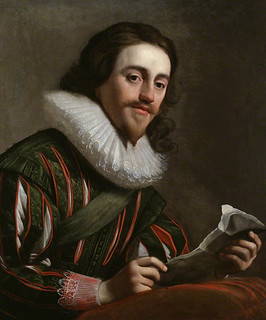 Charles legitimised the ceremony by adding a service of healing to the official prayer
book. He also banned anyone who was not him from attempting to cure ill people by
touching. It was all part of a propaganda plot to prove he had divine backing. There
were instances of accredited healing miracles. A former Puritan called Lord Poulett’s
daughter was cured and he became a strong supporter of the Royalists.
Charles legitimised the ceremony by adding a service of healing to the official prayer
book. He also banned anyone who was not him from attempting to cure ill people by
touching. It was all part of a propaganda plot to prove he had divine backing. There
were instances of accredited healing miracles. A former Puritan called Lord Poulett’s
daughter was cured and he became a strong supporter of the Royalists.
In 1642 the king was forced by the Civil War to move his court to Oxford. Even though there was fighting going on Parliament granted passes to people to travel along the river Thames to Oxford with sick children to be touched in the hope of a cure. In 1643 there was petition from people wanting their king back to London for the touching. This too was a piece of propaganda, possibly from moderates wanting to mediate a settlement.
After the Civil War when Charles was in captivity in Northamptonshire and then on the Isle of Wight the touching ceremonies continued but was unable to hand out coins. The public brought their own ribbons and souvenirs for him to touch. Stories of Charles curing the lame and blind built up an image of a Christ like King and eventual martyr.
After his execution there was a scrabble for his mementos and clothes dipped in royal blood. After Charles’ death an enterprising businessman set out tours to the continent for people who wanted to be cured by Charles II in exile. He was an enthusiastic “toucher” in more than one way” One of his illegitimate offspring, the Duke of Monmouth, later tried to seize the crown. One of the charges against him was he pretended to use the Royal touch.
To read the Wikpedia entry on Charles I, see:
Charles I of England
(https://en.wikipedia.org/wiki/Charles_I_of_England)
To read the earlier E-Sylum article, see:
THE ROYAL TOUCH AND SOCIAL DISTANCING
(https://www.coinbooks.org/v23/esylum_v23n22a12.html)
NOTES FROM E-SYLUM READERS: JUNE 7, 2020
On the Tom Elder/Paul Seitz Family Connection
Regarding the Tom Elder/Paul Seitz family connection,
Ron Haller-Williams writes:
"I find that Kay O. Freeman had indeed done some digging - and guess where it's referenced as being written up!"
Ron located an article in the March 6, 2011 E-Sylum. Dave Hirt's comment was one of the last items I added to the last week's issue. I remembered him bringing up the subject before but didn't search our archives for details. Here's the earlier article. My summary: "Between Kay's research and Dave's conversation with Seitz himself, it seems that Seitz was NOT Tom Elder's son-in-law, although there was a more distant family relationship." -Editor
To read the earlier E-Sylum article, see:
WAS PAUL SEITZ THOMAS ELDER'S SON-IN-LAW?
(https://www.coinbooks.org/esylum_v14n10a17.html)
More on Dancing on Rainbows
Regarding the author of the book Dancing on Rainbows,
Bob Van Arsdell writes:
Bob clued me in that “Roy G. Biv” is a mnemonic device for the order of the colors in the electromagnetic spectrum - Red-Orange-Yellow-Green-Blue-Indigo-Violet." I'd never heard that expression before. -Editor
Jeremy Haag writes:
"Thank you for the Dancing on Rainbows new book announcement in the last E-Sylum. I got a good laugh out of the author’s pen name “Roy G. Biv.” This is a grade-school science acronym to help remember the colors of the rainbow - red, orange, yellow, green, blue, indigo, and violet. An apt name to be associated with a book celebrating the rainbow colored hues on toned coins."
Bob adds:
"So, the author’s actually “anonymous”. I see all the listings on eBay, all but one from the usual aggregators who solicit orders then go find the book to sell. The only one who’s not a aggregator seems to be a seller who occasionally lists toned coins for sale. I wonder if anyone actually has a copy (the eBay feedback ratings notwithstanding)."
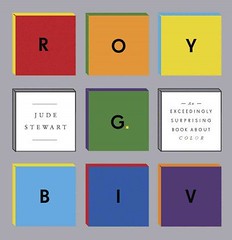 Thanks, guys.
So far no one's mentioned having a copy or offered a review.
Meanwhile, since E-Sylum readers are curious folks, here's a whole book about color itself.
-Editor
Thanks, guys.
So far no one's mentioned having a copy or offered a review.
Meanwhile, since E-Sylum readers are curious folks, here's a whole book about color itself.
-Editor
For an interview with the author of the color book, see:
Read The Rainbow: 'Roy G. Biv' Puts New Spin On Color Wheel
(https://www.npr.org/2013/09/15/222075589/
read-the-rainbow-roy-g-biv-puts-new-spin-on-color-wheel)
To read the earlier E-Sylum article, see:
NEW BOOK: DANCING ON RAINBOWS
(https://www.coinbooks.org/v23/esylum_v23n22a04.html)
The Six-Foot Hypotenuse
Ken Berger writes:
 "The figure which accompanies the article, "STAY HEALTHY AND STAY SAFE" - Bourse Table Spacing, shows that only the diagonals are adhering to the 6-foot distance rule. The horizontal and vertical distances are not. If the coins make an isosceles right triangle and the diagonal (i.e. hypotenuse) is 6-feet then the other two sides (i.e. the horizontal & vertical, known as the legs) are of equal length. Using the Pythagorean Theorem, which we all learned in school, we find that the other two sides are approximately only 4.24 feet. If we want all the coins to be a minimum of 6 feet apart, then the diagonal distance (hypotenuse) would have to have a length of approximately 8.49 feet (again assuming an isosceles right triangle).
"The figure which accompanies the article, "STAY HEALTHY AND STAY SAFE" - Bourse Table Spacing, shows that only the diagonals are adhering to the 6-foot distance rule. The horizontal and vertical distances are not. If the coins make an isosceles right triangle and the diagonal (i.e. hypotenuse) is 6-feet then the other two sides (i.e. the horizontal & vertical, known as the legs) are of equal length. Using the Pythagorean Theorem, which we all learned in school, we find that the other two sides are approximately only 4.24 feet. If we want all the coins to be a minimum of 6 feet apart, then the diagonal distance (hypotenuse) would have to have a length of approximately 8.49 feet (again assuming an isosceles right triangle).
Luckily coins do not have to follow the 6-foot rule."
Good point. I jury-rigged that diagram by plopping coin images over a graphic I found on the web. But Ken's right - if the diagonals are six feet, the sides of the outer square must be shorter. Can anyone point me to a more accurate graphic? "8.49 feet" isn't quite as memorable... or should I say "catchy"? -Editor
To read the earlier E-Sylum article, see:
CORONAVIRUS UPDATES: MAY 31, 2020 : Bourse Table Spacing
(https://www.coinbooks.org/v23/esylum_v23n22a13.html)
More on the Medal of Honor Law
Alan V Weinberg writes:
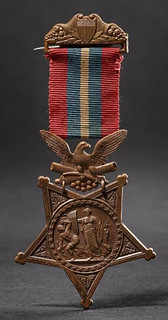 "At the Jan FUN bourse I was actually offered a fully intact Civil War era ribboned Medal of Honor at $15K ( presumably negotiable ) and was shown a cell phone picture of it. Regrettably I had to decline because of this silly law initiated at the urging of a highly placed military officer
influencing Congress. The officer was offended by people wearing military decorations they had not earned.
"At the Jan FUN bourse I was actually offered a fully intact Civil War era ribboned Medal of Honor at $15K ( presumably negotiable ) and was shown a cell phone picture of it. Regrettably I had to decline because of this silly law initiated at the urging of a highly placed military officer
influencing Congress. The officer was offended by people wearing military decorations they had not earned.
"I can vividly recall decades ago when M of Hs from Indian War and Civil War eras were being regularly offered at $25K + at major militaria and gun shows ...until this Congressional law was passed. What a loss to the numismatic hobby - as if someone would be walking around wearing a genuine Medal of Honor!"
Thanks. If the problem was with people wearing medals they haven't earned, then why wasn't the law confined to that? That might make a little more sense, though exceptions would have to be made for military reenactors and theatrical actors; and what about replica medals? Unintended consequences can pile up fast. -Editor
To read the earlier E-Sylum article, see:
MEDAL OF HONOR SOLD IN GERMANY
(https://www.coinbooks.org/v23/esylum_v23n22a31.html)
Numismatic Scrapbook reprints
Dave Hirt writes:
"The post on the Hazelwood family and their reprints was quite interesting to me. Especially the Numismatic Scrapbook reprints. These are very deceptive in my opinion. The originals of volume one can be identified by the colored border, especially if compared side by side. However while searching through a dealer's stock, that may be hard to remember. The reprints of volume two are even more deceptive. I pulled out my copies, and on close examination, I am suspicious that my set of vol. two numbers 1-4 are reprints. I have a single issue of vol. two #4, and it is 1/8" larger, and a darker yellow. This is quite a shock to me. I have owned them for over 30 years."
To read the earlier E-Sylum article, see:
FLOYD HAZELWOOD'S OLYMPIC PRESS
(https://www.coinbooks.org/v23/esylum_v23n22a19.html)
A Gentle Madness
Cole Hendrickson writes:
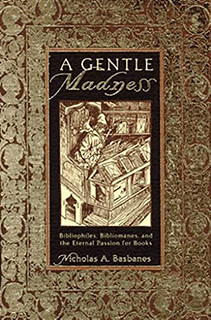 "In a recent episode of the Coin World podcast there was a mention to the book A Gentle Madness: Bibliophiles, Bibliomanes, and the Eternal Passion for Books by Nicholas Basbanes. This prompted me to purchase a copy of the book which I am now reading. It has likely been discussed before in The E-Sylum but I wanted to point it out as it is a wonderful book and one that many bibliophiles would likely enjoy."
"In a recent episode of the Coin World podcast there was a mention to the book A Gentle Madness: Bibliophiles, Bibliomanes, and the Eternal Passion for Books by Nicholas Basbanes. This prompted me to purchase a copy of the book which I am now reading. It has likely been discussed before in The E-Sylum but I wanted to point it out as it is a wonderful book and one that many bibliophiles would likely enjoy."
Yes, it's a fascinating book. I still have my first edition copy on the shelf. There have been a number of books written about bibliophiles, and this is a good introduction. Below are links to some earlier E-Sylum mentions of it. -Editor
To read earlier E-Sylum articles, see:
BOOK HUNTING IN BRITAIN
(https://www.coinbooks.org/esylum_v08n48a13.html)
LECTURE BY AUTHOR OF "A GENTLE MADNESS"
(https://www.coinbooks.org/esylum_v13n14a16.html)
QUERY: HAVEN O'MORE, WORLD'S GREATEST BOOK COLLECTOR
(https://www.coinbooks.org/esylum_v13n16a20.html)
Damage or Charm?
Nick Graver writes:
"This concerns a medal that, hopefully will be part of an article in the future. The medal, significant for the article, has mild scratches on the reverse, apparently carried as a pocket piece by the recipient.
Numismatically it is somewhat impaired, but historically there is a certain 'charm' that shows daily use by the owner, whose name is inscribed on it.
Would readers care to discuss this case of Damage versus Charm? It is the only piece I am aware of, so it is not just a matter of looking for a better example."
Rare Carausius Antoninianus Sells
David Sundman forwarded this follow-up on the sale of a coin featured last week. Thanks. -Editor
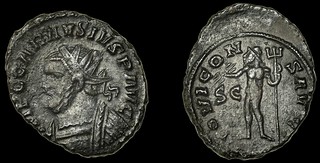 A RARE Roman coin discovered in Colchester more than 40 years ago has sold for £4,000 after going under the hammer.
A RARE Roman coin discovered in Colchester more than 40 years ago has sold for £4,000 after going under the hammer.
Kevin Scillitoe found the coin, minted by the Emperor Carausius, when he was ten-years-old.
Dave adds:
"I wonder if the buyer was an E-Sylum reader. If so, a testimonial from him could help you sell advertising space."
We may never know about this one, but I often hear from readers that they purchased an item that was discussed here in The E-Sylum. And for books, a mention here has led to sellouts twice this year alone. One seller reported: "Oh. my. God! The floodgates opened as soon as the article went out. Lots of orders last night and today - I believe it will clean us out!" -Editor
To read the complete article, see:
Rare Roman coin discovered in Colchester by schoolboy 40 years ago sells for £4,000
(https://www.gazette-news.co.uk/news/18499219.rare-roman-coin-discovered-colchester-schoolboy-40-years-ago-sells-4-000/)
To read the earlier E-Sylum article, see:
DNW OFFERS RARE CARAUSIUS ANTONINIANUS
(https://www.coinbooks.org/v23/esylum_v23n22a26.html)
Custom Slab Labels
Nick Graver writes:
"I was given a Saint Gaudens Eagle ($10 gold) piece as a wedding present from my wife 61 years ago. It was recently mounted in a slab by NGC and looks very nice even though it does not say it is a USA coin, just the date, denomination and grade.
I'd like to have a label permanently attached, denoting this wedding present, that might help it survive in the family for future generations. Is there a commercial service available, or have readers devised an attractive do-it-yourself method?"
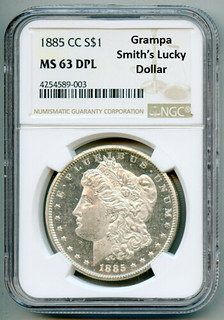 Good question. While custom holder solutions have been available for years (such as Capitol Plastics holders), I'm not sure how one would go about augmenting a grading company slab after the fact. Maybe a printer could make a nice custom CAC "green bean" style sticker. Even better would be for the grading company itself to include custom text on its label per your instructions.
Good question. While custom holder solutions have been available for years (such as Capitol Plastics holders), I'm not sure how one would go about augmenting a grading company slab after the fact. Maybe a printer could make a nice custom CAC "green bean" style sticker. Even better would be for the grading company itself to include custom text on its label per your instructions.
It's too late for that now that the coin has already been slabbed, but the grading companies do have "reholding services" where they'll accept previously-graded coins for new holdering. They certainly do add provenance information to their labels for larger collections, but I'm not aware of any label content for individual sentimental reasons. Maybe this is a new service they could offer someday. I have a one dollar gold piece that my step-grandfather received from his Sunday school teacher. It would be nice to have it slabbed and appropriately labelled for posterity. -Editor
David Lange of NGC confirms:
"NGC will do such customized holders in bulk for numismatic events and, sometimes, for coin clubs. It does not do this for individuals seeking a single customized coin, though it will provide a provenance with the collection name."
Thanks. Can anyone suggest other options for one-off custom labeling? -Editor
THE NASBY CUP
A Yale University Art Gallery email highlights an amazing silver trophy adorned with coins, including a rare New England shilling described in a 2018 article by Associate Curator of Numismatics Ben Hellings. -Editor
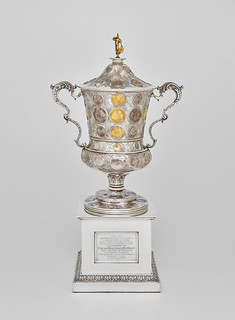
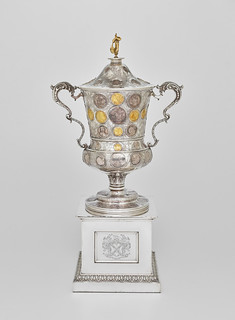
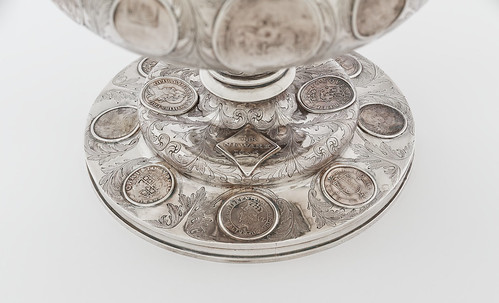
Here's an excerpt from Ben's 2018 Journal of Early American Numismatics article. -Editor
The third specimen at Yale is special and only resurfaced in September 2017 while some of the collection in offsite storage was assessed. The New England shilling, together with 71 other coins, counters, and medals from the period of the English Civil Wars, is integrated into a magni?cent silver trophy that commemorates the Battle of Naseby in 1645 during which Cromwell defeated King Charles I, and ultimately led to the latter’s defeat in the First English Civil War. The hallmarks on the cup identify that it was produced in London in 1839 by Charles Reily and George Storer. The pedestal of the cup claims that the coins and medals are illustrative of the period and that many of them were dug at the scene of action.
The commissioners of the cup, John and Mary Frances Fitzgerald, owned a larger manor nearby the battle?eld. They also erected a commemorative obelisk nearby so it is conceivable that some of the coins integrated within the silver trophy were found on the battle?eld. The heavily worn condition of some of the coins does stand at odds with the many surrounding rare and near-mint state coins, revealing that some may have been found on the ?eld while others were deliberately collected for the cup. The New England shilling, however, cannot have been lost on the ?eld of battle since it occurred prior to the striking of the coin, although it certainly belongs to the same era.
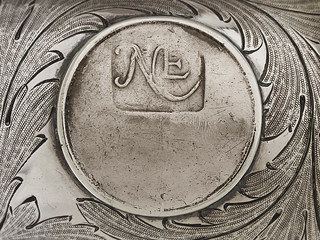 The question remains how, when, and why a New England shilling ended across the Atlantic in Britain. A terminus ante quem is provided by the date of the silver cup (1839). It must therefore have been available before then, delimitating a ca. 187-year period when the coin could have travelled across the Atlantic. At least one other New England shilling was present in Britain at the same time since it was donated to the British Museum in 1818 and was previously owned by Sarah Sophia Banks, a sophisticated
numismatist.
The question remains how, when, and why a New England shilling ended across the Atlantic in Britain. A terminus ante quem is provided by the date of the silver cup (1839). It must therefore have been available before then, delimitating a ca. 187-year period when the coin could have travelled across the Atlantic. At least one other New England shilling was present in Britain at the same time since it was donated to the British Museum in 1818 and was previously owned by Sarah Sophia Banks, a sophisticated
numismatist.
Although there was no prohibition against the export of large quantities of Massachusetts silver until 1654, it is known that coins thereafer did pass searchers with some ending up in Britain. This offers one possible circumstance for the NE shilling to travel to Britain. The pieces, however, are unlikely to have been extensively used in trade with Britain since the New England shillings struck at a standard of 72 grains contained less silver than the English standard of 92.9 grains. The New England shillings would therefore have been unappealing to use in Britain where they could have been valued less than their face value. It is therefore possible that these coins came to Britain as a (numismatic) collector’s item.
The specimen in the cup is in exceptional condition indicating that it may not have circulated extensively. If this is the case, the coin could have come to Britain shortly afer its manufacture or remained in a (savings) hoard in the U.S. It may have come as part of the elite network on both sides of the Atlantic in which wealthy colonials adopted and continued old European practices of collecting and displaying silver. If so, it could have travelled with collections during the exodus of elite loyalists to Britain in the context of the American Revolution (although saving this coin in such a context would be peculiar). At the same time of the coin’s manufacture, however, numismatics was starting to become a serious ?eld of study in Britain o?ering yet another possible circumstance for the coin’s presence in Britain. Whenever the coin did travel, the condition of the coin does allow us to speculate that it was speci?cally preserved for a collection or display purpose.
The question remains why a New England shilling appears on a cup commemorating a battle of the English Civil Wars. The coin certainly belongs to the period and several other foreign coins are included. Most of the “foreign” coins were those struck in Ireland and Scotland during the Civil Wars so their connection is clearer. A Spanish-American cob from Mexico City, struck under Philip V of Spain in the early 1700s, is also featured but there are several recorded ?nds of earlier cobs in Britain.
The New England shilling may therefore have been included since it alludes to a period of unrest and turbulence that spread beyond the borders of Great Britain and Ireland. It also was the ?rst coinage from the Puritans of the Massachusetts Bay, whose inhabitants supported their puritan brethren in Britain against King Charles I in the Civil Wars. Since Cromwell was a puritan and headed a puritan commonwealth in Britain, it therefore may have seemed appropriate to include a coin from the Massachusetts Puritans commemorating their assistance.

To read the complete newsletter, see:
YALE UNIVERSITY ART GALLERY
JUNE 1–7, 2020
(https://mailchi.mp/yale/w1zb8yl4r8?e=18ae8308f6)
To hear the story of the Nasby Cup, see:
Nasby Cup
(https://soundcloud.com/yaleartgallery/ag137199)
To read Ben's 2018 Journal of Early American Numismatics article, see:
(Re-)Discovery: Yale’s second and third Noe II-A New England Shillings
(https://www.academia.edu/36287985/_Re-_Discovery_Yale_s_second_and_third_Noe_II-A_New_England_Shillings)
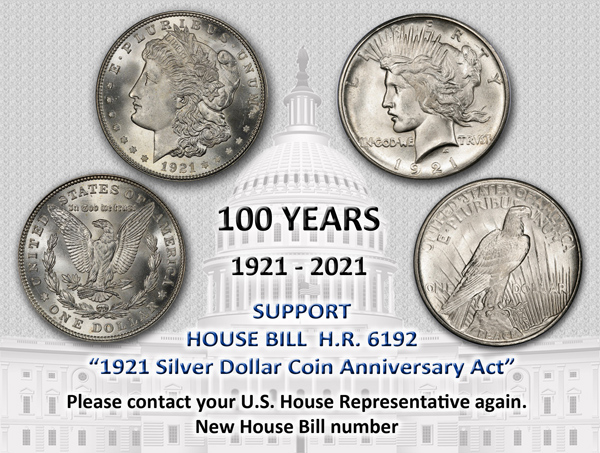
VOCABULARY TERM: MEDAL
Dick Johnson submitted this back-to-basics entry from his Encyclopedia of Coin and Medal Terminology. Thanks. I added some images. -Editor
Medal. A memorial piece, of historic, commemorative, or artistic design, made in any of various ways – basically cast or struck – originally in the shape similar to a coin (but without denomination and certainly not intended to pass for money). In general, the word medal includes all forms of medallic items (except plaques); but also has a specific, numismatic definition: A medal is a round, or nearly so, medallic item between one and approximately three inches (25–80mm) diameter.
Early use of term medal. As all-encompasing a term as is “medals” – meaning almost everything medallic – the term originally meant even more. It once meant uncurrent coins as well, particularly those housed in collections. Undoubtedly this came from the early Low Latin word medalla which meant “a small coin.”
Numismatic curator Jean Babelon once wrote: “In Italy the term ‘medal’ was applied to pieces preserved in collections because they were no longer current and had a purely scientific or historical interest.” This was expressed in the title of a classic work by John Addison in the 17th century, “Dialogues upon the Usefulness of Ancient Medals,” was a book on ancient coins!
Medal characteristics. Medals have a very wide appeal, both for their beauty, artistic design, topical subject matter and ability to present a portrait, but also for their historic value. Medals are the most ideal form of commemorating an event or person because of their permanence. We know of events from the past, where and when – and who was involved – because of medals. Medals can exist and pass on these pictorial elements and lettering to people in the future for thousands of years.
Medals are the link between numismatics and virtually everyone in the world. They are the most coveted, distinctive way to honor a scientist, humanitarian or athlete. Every intelligent person in the world knows of the award ceremony of the Nobel Medal in Sweden, or the Olympic medals on the tri-tiered steps at the Olympic games. Medals can be created to honor the school child for excellence in studies, or the inventor of a lifesaving serum. Medals are permanent records of man’s achievements, noble events, and personal accomplishments!
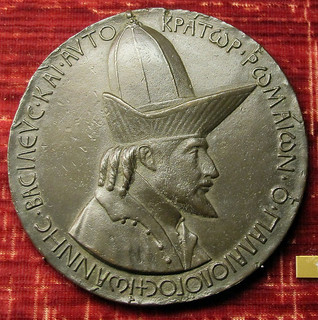
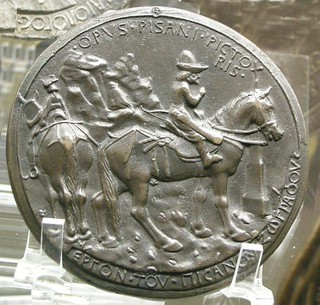
https://en.wikipedia.org/wiki/Medal_of_John_VIII_Palaeologus
Medals are also an ideal medium for portraits. The first use of the medal created by Pisanello in 1438 was to bear a portrait. Royal families took to medals for individual portraits and passed them to other royal families much like we send family photographs today.
Of equal importance to the pictorial element on medals – its DEVICE – is its inscription, the lettering that names, explains, describes or amplifies the device. The obvious shortcoming of lettering is, of course, it has to be in a language that perhaps will not be in existence a thousand years from now. Can anyone read it then?
Just as we observe two-thousand year old coins with inscriptions in a dead language, will the language we put on medals today be understandable in the distant future? Will scholars of the future study English as a forgotten, obsolete tongue? Yet we have no other choice.
The chore rests with the medal designer, its creator. The goal is to design both device and inscription so attractive, so desirable, so enchanting, so appealing to be important enough to want to preserve it. Forever. Desired by both individuals and museums alike to want to posses it for the recall of its substance. To remember why it was issued.
Medal Characteristics
1) Longevity (Long lasting).
2) Beauty (Artisticness).
3) Image (Portraiture, Award, Honor).
4) Commemoration (Celebration).
5) Perspective Charm (Miniature Art).
6) Narration (Picture & Legend).
7) Intimacy (Personal Size).
8) Permanence (Hard Form).
9) Bilateral (Two-sidedness).
10) Accuracy (Documentation).
Looking for the meaning of a numismatic word, or the description of a term? Try the Newman Numismatic Portal's Numismatic Dictionary at: https://nnp.wustl.edu/library/dictionary
Or if you would like a printed copy of the complete Encyclopedia, it is available. There are 1,854 terms, on 678 pages, in The Encyclopedia of Coin and Medal Technology. Even running two a week would require more than 19 years to publish them all. If you would like an advance draft of this vital reference work it may be obtained from the author for your check of $50 sent postpaid. Dick Johnson, 139 Thompson Drive, Torrington, CT 06790.
HERBERT E. ROWOLD (1898-1955)
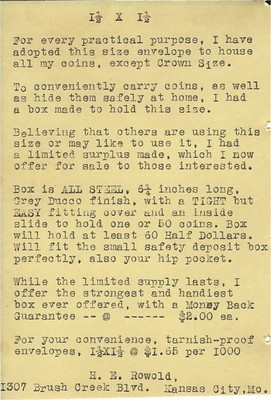 Herbert E. Rowold (1898-1955), was born on July 12, 1898, at Marquette, Wisconsin. He married his wife Freda B. Griffith (1896-) on December 3, 1921. They lived at 1509 East 10th Street, Kansas City, Missouri. In 1923 they lived at 1510 Forest Avenue, Kansas City, Missouri. In 1930 he lived at 113 Gillham Road, Apt. 1, Kansas City, Missouri., and worked as a shoe salesman, and Freda was the apartment building manager. Later on he resided at 1307 Brush Creek Boulevard, Kansas City, Missouri.
Herbert E. Rowold (1898-1955), was born on July 12, 1898, at Marquette, Wisconsin. He married his wife Freda B. Griffith (1896-) on December 3, 1921. They lived at 1509 East 10th Street, Kansas City, Missouri. In 1923 they lived at 1510 Forest Avenue, Kansas City, Missouri. In 1930 he lived at 113 Gillham Road, Apt. 1, Kansas City, Missouri., and worked as a shoe salesman, and Freda was the apartment building manager. Later on he resided at 1307 Brush Creek Boulevard, Kansas City, Missouri.
He was a coin dealer and specialist in the study of Illinois State sales tax tokens and designed and created the 1-1/2" x 1-1/2" paper coin envelopes and their metal storage boxes.
He died in Kansas City, Missouri on April 28, 1955. He is buried at Osawatomie, Miami County, Kansas
To read the complete article, see:
ROWOLD, HERBERT E.
(https://sites.google.com/site/numismaticmallcom/encyclopedic-dictionary-of-numismatic-biographies/rowold-herbert-e)
HARVEY STACK'S NUMISMATIC FAMILY, PART 71
The latest article in Harvey Stack's blog series is about the year 1977. Thanks, Harvey. -Editor
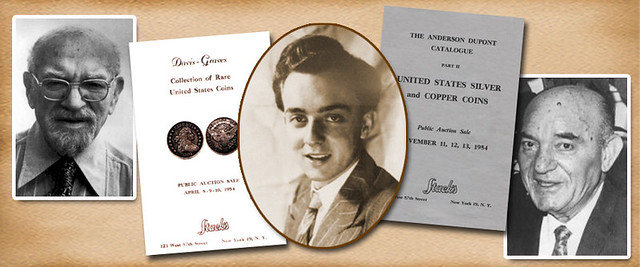
After having a very successful year in 1976, the market seemed to want to keep growing, as people saw coin values going up. While 1977 opened with a slow start in January, enthusiasm grew and the hobby became very active. This was helped by prominent cabinets coming on the market, as certain collectors either passed away or decided they were getting too old to continue. This cycle of excellent material coming up for auction and encouraging new collectors to increase their participation, created a market that was dynamic and exciting. Not only did this impact the public auction sales that Stack's conducted almost monthly, but it also enhanced over the counter trade at our New York City store.
The Bicentennial celebrations that started in 1976 carried forth into 1977, as many exhibits were planned for a two-year period. Both New York City and Philadelphia had numerous places to visit and experience the nation's early history. In New York we received many visitors and collectors due to this ongoing event. Our retail shop was always crowded, and the seven auctions we conducted were always had lots with excited bidders. At this time, in-person attendance at auctions was the norm and the bidding that went on between attendees provided great entertainment. In these days before Internet, fax and phone bidding, we did accept bid sheets by mail, acting as agents for the clients who sent them. There were also those attending the sale that bid not only on their own behalf, but also for clients or friends who could not attend.
But the drama of the auction all took place "in the room." As I had been a licensed auctioneer since 1955, I had a great perspective from the podium and could watch the action in the room and learn how different bidders executed bids and observe the interplay that occurred between them. "Working the room" as an auctioneer required skill and experience, and the more of both I gained added to my enjoyment of the experience. While those times required a commitment of time and money on the part of bidders to attend auctions, they also fostered a community experience that made auctions very exciting and a lot of fun.
There were other ways that the coin market was changing. In 1972 the American Numismatic Association had launched ANACS – the American Numismatic Association Certification Service. This service was started to combat counterfeit and altered coins that continued to enter the market. The coin experts at ANACS would provide guidance as to whether a coin was genuine or counterfeit. This was a big help, especially to beginning collectors.
At the same time, the ANA had to continued to work on their grading standards, a project begun a few years earlier. Finally the standards were ready and The Official ANA Grading Standards for United States Coins was published. In time, ANACS would use these standards to assess the coins that were sent in and assign them grades, beginning the move toward third-party coin grading that would eventually cause a sea change in numismatics.
Stack's had always maintained a staff of highly qualified experts and so was able to offer our clients assurance that the numismatic items they bought from us were authentic, accurately graded, and well priced. Members of our staff wrote reference books and, in fact, four later became curators of national numismatic collections. Offering a wide variety of specialties, these experts were always there to help collectors, whether beginning or advanced, and also to provide instruction to me and the other Stack family members as we grew as professional numismatists.
To read the complete article, see:
Harvey Stack Remembers: Growing up in a Numismatic Family, Part 71
(https://www.stacksbowers.com/News/Pages/Blogs.aspx?ArticleID=Harvey-Stack-Remembers-Part-71)
To read the earlier E-Sylum article, see:
HARVEY STACK'S NUMISMATIC FAMILY, PART 70
(https://www.coinbooks.org/v23/esylum_v23n21a18.html)
THE QUINT MINT
 A clipping of a November 27, 1968 Coin World article by Jim Johnson led me to search for more information on the "Quint Mint" of Philadelphia. The firm evolved with the times and still exists today. It produced medals. tokens, baggage checks, store cards and Masonic chapter pennies.
Here's a short history from the company web site illustrated with a 1922 photo of their building.
-Editor
A clipping of a November 27, 1968 Coin World article by Jim Johnson led me to search for more information on the "Quint Mint" of Philadelphia. The firm evolved with the times and still exists today. It produced medals. tokens, baggage checks, store cards and Masonic chapter pennies.
Here's a short history from the company web site illustrated with a 1922 photo of their building.
-Editor
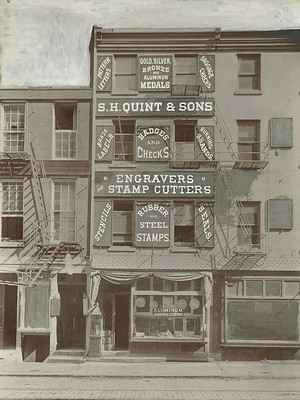 Quint Company was founded in 1849 by S.H. Quint making its mark on Old City Philadelphia’s history. For 100 years their offices at 4th & Chestnut Streets, sometimes referred to as the Quint Mint, produced stamps, stencils, medals, badges, rags and coins such as the Masonic Chapter pennies.
Quint Company was founded in 1849 by S.H. Quint making its mark on Old City Philadelphia’s history. For 100 years their offices at 4th & Chestnut Streets, sometimes referred to as the Quint Mint, produced stamps, stencils, medals, badges, rags and coins such as the Masonic Chapter pennies.
Over the years, our company, founded on a gold-rush fortune, has been continually making history. In 1876 Quint Company was recognized at the Centennial Celebration- a commemorative stencil was created in honor of the event. Quint products have even traveled to the moon, aboard the fourth Apollo mission in 1969.
In 1971, after more than 100 years on 24 South 4th Street, Quint expanded to larger offices on Letitia Street to further develop its graphics division. Today, the Quint Company has grown from a small stamp and stencil producer to a full service manufacturer, capable of servicing every facet of the marking and packaging industries. Now with offices on Castor Avenue, we have merged years of industry experience with advanced technological equipment to provide customers with the best end products available.
A search on the Newman Portal only turned up a few mentions of the firm. Besides the Coin World piece there was an article on the March 1988 issue of Scrip Talk from the National Scrip Collectors Association (NSCA) and just a few other short mentions. Here's one of their medals from the So-Called Dollars site. -Editor
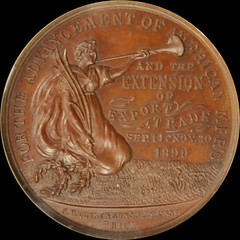

National Export Exposition Official Medal
1899 • SH 10-11 BZ
Year 1899
Obverse features a female blowing a trumpet making an announcement as the legend states “For the Advancement of American Mfr’s and the Extension of Export Trade Sep. 14 to Nov. 30 1899”. Signed S.H. Quint & Sons.
To visit the company web site, see:
https://www.quintco.com/
Photo credits:
S.H QUINT & SONS, MEDALS MAKER, PHILADELPHIA, PA. MEDAL
(https://www.worthpoint.com/worthopedia/h-quint-sons-medals-maker-82936103)
S. H. Quint and Sons, Engravers and Stamp Cutters
(https://libwww.freelibrary.org/digital/item/5745)
National Export Exposition Official Medal
(http://www.so-calleddollar.com/scd/national-export-exposition-official-medal/)
MORE DAVISSON'S E-AUCTION 35 SELECTIONS
The Davisson's E-Auction 35 closes June 10, 2020. Here are some additional selections. See the full sale online for more. -Editor
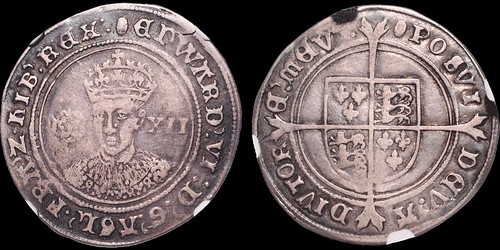
E-Auction 35 Lot 75: Edward VI. 1547-1553. AR shilling. 6.01 gm. 32.5 mm. Third period, fine silver issue. Tun i.m. 1551-1553. Crowned facing bust, rose to left, XII to right / Royal shield over long cross fourchée. S. 2482. N. 1937. NGC VF 25; a full round flan; a touch of red in the old gray toning.

E-Auction 35 Lot 104: Victoria. 1837-1901. AR Gothic florin. 11.32 gm. 30 mm. (1870) mdccclxx, die number 17. Her crowned bust left / Cruciform crowned arms; roses, a thistle, and a shamrock in angles. S. 3893. ESC 2870 (836) (S). Extremely Fine; fresh lustrous surfaces underlying a pleasing light toning.
The Frank Robinson Collection.
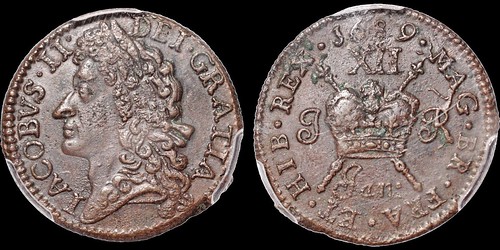
E-Auction 35 Lot 122: IRELAND. James II. 1685-1691. Æ gunmoney shilling. 26 mm. Large format. January 1689. His laureate bust left; IACOBVS II DEI GRATIA (Obv 1) / Two scepters in a saltire behind a crown, XII above, month (Jan) of issue below; J R on sides (Rev C). S. 6581 M. D&F 421. Timmins TB12H-1C (Dublin). PCGS AU53; well struck on good metal; die break through MAG on reverse. Light scratches visible in photo are in slab plastic, not coin.

E-Auction 35 Lot 182: UNITED STATES. Draped bust large cent. 10.62 gm. 28 mm. 1800. Sheldon 205. Breen dies 17-T. Good Very Fine; characteristic obverse die break; some thin scratches on obverse.
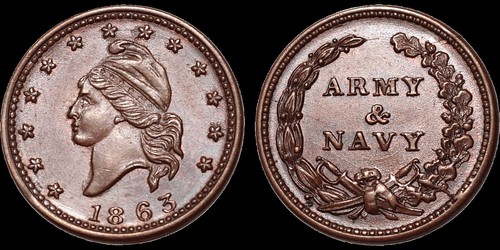
E-Auction 35 Lot 204: Civil War Patriotic Token. Copper. 3.26 gm. 19 mm. 1863. Liberty head left / ARMY & NAVY. Fuld 11/298a. Uncirculated; a few tiny die breaks on reverse. Choice example.
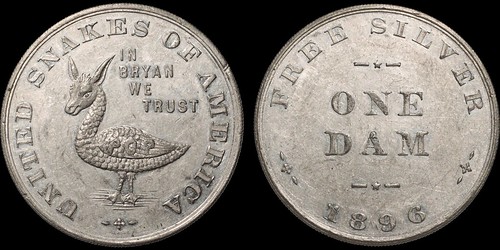
E-Auction 35 Lot 221: UNITED STATES. Bryan Money. White metal. 20.23 gm. 44 mm. 1896. A donkey-headed goose; IN BRYAN WE TRUST in field; UNITED SNAKES OF AMERICA around / ONE DAM in center; FREE SILVER above; 1896 below. Good Extremely Fine; lightly toned, iridescence; fresh example (this type often offered impaired).
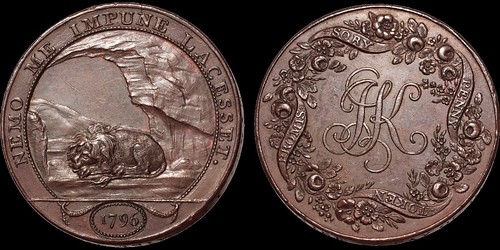
E-Auction 35 Lot 139: Warwickshire 20. Birmingham. Kempson. Copper penny. 25.74 gm. 33 mm. A lion sleeping in a cave; NEMO ME IMPUNE LACESSET around, 1796 in a sunken oval in exergue / JK cypher within a wreath of flowers; on an entwined ribbon PROMIS-SORY PENNY TOKEN is inscribed. Edge: I PROMISE TO PAY ON DEMAND THE BEARER ONE PENNY. Good Extremely Fine.
The Mike Sussman Collection of British Trade Tokens.
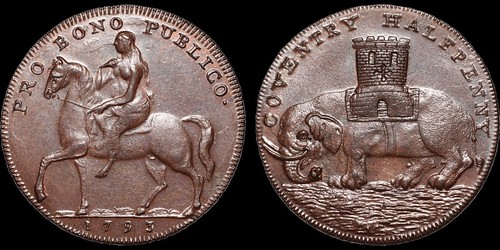
E-Auction 35 Lot 156: Warwickshire 238. Coventry. Copper halfpenny. 9.61 gm. 29.5 mm. 1793. Lady Godiva on horseback; PRO BONO PUBLICO• around, 1793 below / Elephant and castle (Arms of Coventry); COVENTRY HALFPENNY around. Edge: PAYABLE AT BIRMINGHAM LONDON OR BRISTOL. Uncirculated; glossy light brown; choice, almost prooflike.
The Mike Sussman Collection of British Trade Tokens. With old Baldwin tag.
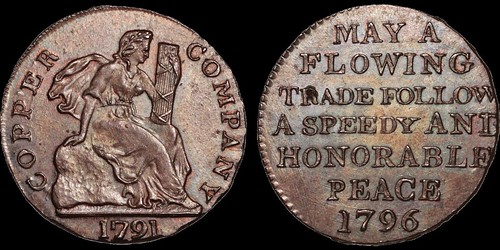
E-Auction 35 Lot 167: Warwickshire 478a (R). Birmingham. Copper farthing. 4.99 gm. 21 mm. 1796. A female seated right on a rock, holding a fasces; COPPER COMPANY on sides, 1791 below / MAY FLOWING TRADE FOLLOW A SPEEDY AND HONORABLE PEACE 1796 in seven lines. Uncirculated; choice.
The Mike Sussman Collection of British Trade Tokens.
(The legend on the reverse sounds like a wish, with slight modification, for the current times.)
For more information, or to bid, see:
https://davcoin.com/
To read the earlier E-Sylum article, see:
DAVISSON'S E-AUCTION 35 SELECTIONS
(https://www.coinbooks.org/v23/esylum_v23n21a22.html)

STACK'S BOWERS FRANCESCA SALE SELECTIONS
Here are a group of lots that caught my eye in the June 2020 Stack's Bowers Francesca collection sale. -Editor
Lot 100: George F. Robinson Medal


"1871" (1873) George F. Robinson Medal. Bronze. 77 mm. Julian PE-27. Mint State.
Choice save for a few wispy handling marks and faint carbon flecks. Handsome medium brown patina throughout. This medal was struck to commemorate George F. Robinson, a soldier who was assigned to protect William H. Seward, the secretary of state under Abraham Lincoln. On the night of April 14, 1865, Lewis Powell, a co-conspirator to John Wilkes Booth, attempted to assassinate Seward in his Washington, D.C. home. That very night President Lincoln had gone to Ford's Theater and was assassinated by Booth. Although Seward was attacked by Powell and suffered considerable stab wounds, he survived. Several of his children were also wounded, along with Robinson. These medals were issued with the obverse showing Robinson's bust left, the reverse with a wild scene of Seward in bed (still recuperating from a recent carriage accident) and Robinson defending against the knife-wielding Powell. The base of the reverse is signed in tiny letters G.Y. COFFIN DES. and PAQUET F. for famed medal engraver Anthony C. Paquet. It is believed that fewer than 100 of these were struck in bronze, and this example is one of the nicest that we have offered in recent sales.
A great medal commemorating a great historical event. -Editor
To read the complete lot description, see:
"1871" (1873) George F. Robinson Medal. Bronze. 77 mm. Julian PE-27. Mint State.
(https://auctions.stacksbowers.com/lots/view/3-N4G82/1871-1873-george-f-robinson-medal-bronze-77-mm-julian-pe-27-mint-state)
Lot 178: C. E. Horns Counterstamp
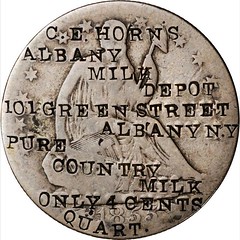

New York--Albany. C.E. HORNS / ALBANY / MILK / DEPOT / 101 GREEN STREET / ALBANY N.Y / PURE / COUNTRY / MILK / ONLY 4 CENTS / QUART on an 1855-O Arrows Liberty Seated half dollar. Brunk-Unlisted, Rulau-Unlisted. Host coin Good.
An impressive amount of information on this unlisted counterstamp, and each letter was stamped individually! All letters are crisp and clear, and host coin displays even steel gray toning.
Wow - that's some counterstamp. It took a lot of work. Very nicely done. -Editor
To read the complete lot description, see:
New York--Albany. C.E. HORNS / ALBANY / MILK / DEPOT / 101 GREEN STREET / ALBANY N.Y / PURE / COUNTRY / MILK / ONLY 4 CENTS / QUART on a...
(https://auctions.stacksbowers.com/lots/view/3-N4IPX/new-york-albany-ce-horns-albany-milk-depot-101-green-street-albany-ny-pure-country-milk-only-4-cents-quart-on-a)
Lot 202: 1786 Vermont Landscape Copper

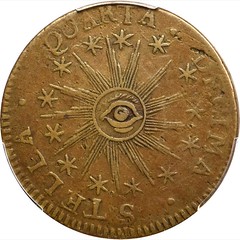
1786 Vermont Copper. Landscape. RR-6, Bressett 4-D, W-2020. Rarity-2. VERMONTENSIUM. EF-45 (PCGS).
A handsome and appealing example of this perennially popular Landscape variety, this piece combines a warmly patinated reddish-brown reverse with a slightly lighter obverse displaying autumn and golden-brown. Both sides are generally well struck with most design elements boldly to sharply defined. The centering is quite good for the type, although the obverse border is through the base of the date, flush to the top of the letters VER in VERMONTENSIUM. On the reverse, the border is flush to the top of the word QUARTA, and the peripheral detail is also soft at the letters DEC in DECIMA. This also affects the letters NTE in VERMONTENSIUM on the obverse. Flan flaws are minor and include only a few thin, shallow fissures, the most prominent of which are on the obverse at and below the letters IU in the legend and on the reverse at the letter D in DECIMA. There is ancient carbon spot at the obverse border after the word VERMONTENSIUM, but otherwise we note only small, wispy handling marks that are inconspicuous to the unaided eye. There is no sign of the obverse crack from the lower border through the center of the date to the plow that characterizes late state examples of RR-6.
This is the popular "Floating Tree" variety of the Landscape Vermont copper, so named due to the fourth (from the viewer's left) obverse tree in the design: it floats in mid air and does not touch the mountain below. Writing in Mason's Coin and Stamp Magazine, April 1867, Ebenezer Locke Mason, Jr. described two additional features of this obverse die:
"The tree to the extreme right does not touch the bank upon which it was intended to stand, but is perceptibly to its right...A third difference is the duplicate letter U in 'PUBLICA,' which the artist, it would appear, made to run too much inwards, so that he duplicated it in a more proper place, but neglected to erase the original. This is my theory--others may suggest a more plausible one."
I've always enjoyed the landscape coppers. Great piece. -Editor
To read the complete lot description, see:
1786 Vermont Copper. Landscape. RR-6, Bressett 4-D, W-2020. Rarity-2. VERMONTENSIUM. EF-45 (PCGS).
(https://auctions.stacksbowers.com/lots/view/3-N4PAD/1786-vermont-copper-landscape-rr-6-bressett-4-d-w-2020-rarity-2-vermontensium-ef-45-pcgs)
Lot 306: 1862 Indian Cent

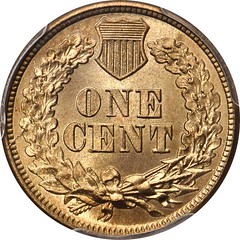
1862 Indian Cent. MS-68 (PCGS).
Here is a magnificent 1862 Indian cent, from the copper-nickel, Oak Wreath series of 1861 through 1864. The surfaces are essentially flawless, with subtle prooflike reflectivity in the fields and undisturbed frosty texture across the devices. A thin die crack is noted at the tip of Liberty's bust and through the left reverse wreath, but the devices remain nicely defined for the issue. The attractive surfaces are golden-tan with subtle accents of deeper bronze patina throughout. A small area of dark toning on Liberty's hair ribbon will help in tracing this superior piece through future cabinets.
With 28,075 pieces struck, the 1862 has the second highest mintage of this short series. Examples of the 1862 are readily available in most Mint State grades up through MS-65, but they become exponentially more elusive approaching Superb Gem condition. In Ultra Gem MS-68 condition, the present piece is an incredible rarity. In fact, this is the sole finest 1862 cent graded by PCGS or NGC, and is tied with the very finest known across the entire Indian cent series. It is an ideal candidate for a high-end PCGS Registry Set of Indian cents or 19th century type coins. It simply cannot be improved upon.
Combined PCGS and NGC Population: 1; none finer for any Indian cent issues.
A gorgeous high-condition coin. -Editor
To read the complete lot description, see:
1862 Indian Cent. MS-68 (PCGS).
(https://auctions.stacksbowers.com/lots/view/3-N4FQP/1862-indian-cent-ms-68-pcgs)
Lot 1005: 1797 Draped Bust Silver Dollar
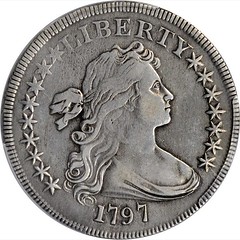

1797 Draped Bust Silver Dollar. BB-73, B-1a. Rarity-3. Stars 9x7, Large Letters. VF Details--Cleaned (PCGS).
This is a well centered example with full, overall broad denticulation encircling the borders. Essentially untoned, the silver gray surfaces exhibit a glossy texture that explains the PCGS qualifier. Bowers-Borckardt 73 is the sole die marriage associated with the Stars 9x7, Large Letters Guide Book variety of the 1797 silver dollar. It ranks in the middle for scarcity among the three known die pairings of the issue. Q. David Bowers (2013) estimates that 1,300 to 2,100 BB-73 dollars are extant in all grades, VF examples such as this particularly desirable for those building a type set on a budget. BB Die State III.
A solid type coin. -Editor
To read the complete lot description, see:
1797 Draped Bust Silver Dollar. BB-73, B-1a. Rarity-3. Stars 9x7, Large Letters. VF Details--Cleaned (PCGS).
(https://auctions.stacksbowers.com/lots/view/3-N4LVL/1797-draped-bust-silver-dollar-bb-73-b-1a-rarity-3-stars-9x7-large-letters-vf-details-cleaned-pcgs)
Lot 1226: 1814/3 Capped Head Left Half Eagle
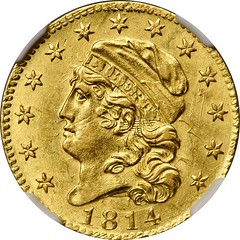
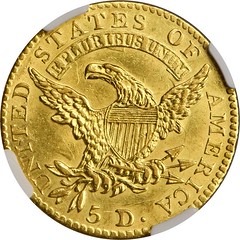
1814/3 Capped Head Left Half Eagle. BD-1, the only known dies. Rarity-4+. MS-62 (NGC).
Offered is an attractive and significant Mint State example of this scarcer Capped Head Left half eagle. Vibrant yellow-gold in color with remarkably smooth fields on both sides. The devices are sharp for the issue, and there is considerable evidence of clashing around the central elements and a trace of planchet adjustment near the rims. Very attractive and heavily lustrous, this is among the most desirable survivors known.
The second issue in the Capped Head Left half eagle series of 1813 to 1834, the 1814 is an overdate with only a single die pairing known. The obverse was initially intended for production in 1813, but was not used and was subsequently overdated for use in the following year. The reverse die also struck the 1813 BD-2 variety, as well as the exceedingly rare 1815. Although federal records report a mintage of 15,454 half eagles during calendar year 1814, the scarcity of this date relative to the 1813 suggests that many of those coins may have been struck from the earlier-dated dies. The mintage for the 1814/3 as an issue may be as low as 10,000 coins (per John W. Dannreuther, 2006). The 1814/3 is far scarcer than the 1813 and we believe that fewer than 150 coins are extant in all grades, perhaps as few as 100.
A beautiful early gold piece. -Editor
To read the complete lot description, see:
1814/3 Capped Head Left Half Eagle. BD-1, the only known dies. Rarity-4+. MS-62 (NGC).
(https://auctions.stacksbowers.com/lots/view/3-N52FJ/18143-capped-head-left-half-eagle-bd-1-the-only-known-dies-rarity-4-ms-62-ngc)
Lot 1247: Proof 1903 Liberty Head Half Eagle

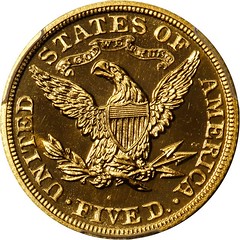
1903 Liberty Head Half Eagle. Proof. Unc Details--Altered Surfaces (PCGS). The Philadelphia Mint struck 154 Proof half eagles in 1903, one of the more generous totals for the type. Most of these coins seem to have been distributed to contemporary collectors, this being one of the more frequently encountered Proof Liberty Head fives in today's market. All classic U.S. Mint Proof gold coins are rare in an absolute sense, however, especially relative to the demand that they enjoy among today's numismatists. The present specimen offers a lot of "coin" for the assigned grade, and it is worthy of a close look and solid bids.
A great low-mintage piece. -Editor
To read the complete lot description, see:
1903 Liberty Head Half Eagle. Proof. Unc Details--Altered Surfaces (PCGS).
(https://auctions.stacksbowers.com/lots/view/3-N51C2/1903-liberty-head-half-eagle-proof-unc-details-altered-surfaces-pcgs)
STACK'S BOWERS MONTANA TOKEN SALE SELECTIONS
And now for something completely different - Stack's Bowers will also be offering the Big Sky Collection of Montana tokens. Here are a few that caught my eye. -Editor

The Big Sky Collection is an outstanding and comprehensive cabinet comprising thousands of trade tokens and related items from Montana and Montana Territory. This collection was assembled by a dedicated enthusiast over decades, and many of these tokens may not be available again for a long time. The collection includes great rarities, common varieties and numerous unlisted tokens. This Stack’s Bowers Galleries sale provides an opportunity that is unparalleled. The Big Sky Collection will be sold in two exclusive Collectors Choice Online auctions in June and August 2020.
Lot 50053: Montana Silver Statue Token

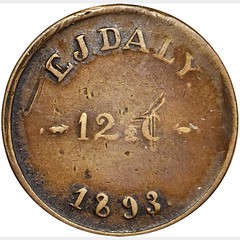
Butte. E. J. DALEY / 12¢ / 1893 // MONTANA SILVER STATUE / WORLD'S FAIR around, and 1492 / 1892 to left and right of female wielding sword and holding scales. 21.4 mm. Copper. Rulau But-9. Rarity-9. VERY GOOD.
Very popular Columbian Exposition pictorial good-for token
Interesting odd-denomination piece. -Editor
To read the complete lot description, see:
Butte. E. J. DALEY / 12¢ / 1893 // MONTANA SILVER STATUE / WORLD'S FAIR around, and 1492 / 1892 to left and right of female wielding swo...
(https://auctions.stacksbowers.com/lots/view/3-N2NW5/butte-e-j-daley-12-1893-montana-silver-statue-worlds-fair-around-and-1492-1892-to-left-and-right-of-female-wielding-swo)
Lot 50055: Knowlton & Lucado Token
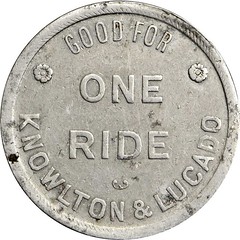

Butte. GOOD FOR / ONE / RIDE / KNOWLTON & LUCADO // GOOD FOR ONE RIDE below image of a tented merry-go-round. 38.0 mm. Aluminum. Atwood 140-I. Rarity-9. VERY FINE.
Variety with American Flag blowing left, and no pennant. Original mint luster remains in the devices and around the legends. A very nice example of this ever popular merchant.
A fun carousel image. -Editor
To read the complete lot description, see:
Butte. GOOD FOR / ONE / RIDE / KNOWLTON & LUCADO // GOOD FOR ONE RIDE below image of a tented merry-go-round. 38.0 mm. Aluminum. Atwood ...
(https://auctions.stacksbowers.com/lots/view/3-N2NVD/butte-good-for-one-ride-knowlton-lucado-good-for-one-ride-below-image-of-a-tented-merry-go-round-380-mm-aluminum-atwood-)
Lot 50059: The Silver Bow Bar Token


Butte. THE / SILVER BOW / BAR / 39 NO. MAIN ST. / BUTTE, MONT. / S. P. GUIMONT / PROP. // GOOD FOR 12 1/2¢ IN TRADE above a life-saver ring enclosing legend A / LIFE / SAVER / IN THE / MORNING. 30.9 mm. Brass. Rarity-8. VERY FINE.
Unusual life-saver pictorial.
To read the complete lot description, see:
Butte. THE / SILVER BOW / BAR / 39 NO. MAIN ST. / BUTTE, MONT. / S. P. GUIMONT / PROP. // GOOD FOR 12 1/2¢ IN TRADE above a life-saver r...
(https://auctions.stacksbowers.com/lots/view/3-N2NWQ/butte-the-silver-bow-bar-39-no-main-st-butte-mont-s-p-guimont-prop-good-for-12-12-in-trade-above-a-life-saver-r)
Lot 50091: The Senate Aluminum Token
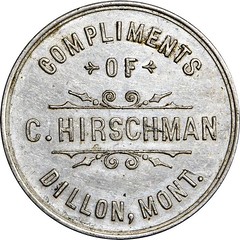
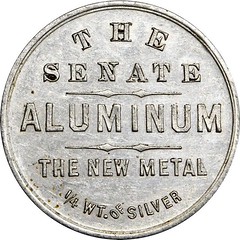
Dillon. COMPLIMENTS / OF / C. HIRSCHMAN / DILLON, MONT. // THE / SENATE / ALUMINUM / THE NEW METAL / 1/4 WT. OF SILVER. 34.7 mm. Aluminum. Rarity-8. ABOUT UNCIRCULATED.
Classic 19th Century storecard noting that it is made from aluminum, the new metal.
Aluminum was the new kid on the block at one time. Cool piece. -Editor
To read the complete lot description, see:
Dillon. COMPLIMENTS / OF / C. HIRSCHMAN / DILLON, MONT. // THE / SENATE / ALUMINUM / THE NEW METAL / 1/4 WT. OF SILVER. 34.7 mm. Aluminu...
(https://auctions.stacksbowers.com/lots/view/3-N2NUK/dillon-compliments-of-c-hirschman-dillon-mont-the-senate-aluminum-the-new-metal-14-wt-of-silver-347-mm-aluminu)
Lot 50154: Lewiston Brewery Saloon
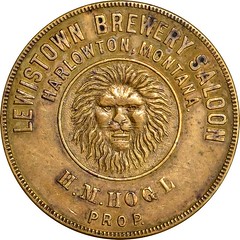
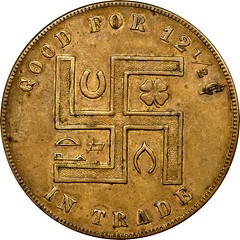
Harlowton. LEWISTOWN BREWERY SALOON / HARLOWTON, MONTANA / H. M. HOGL / PROP. around Lion's Head // GOOD FOR 12 1/2¢ / IN TRADE around Swastika and other good luck symbols. 31.9 mm. Brass. Rarity-9. VERY FINE.
One of the most desirable of Montana merchant tokens. Saloon, lion pictorial, and swastika all wrapped up in one!
Cool yet weird lion. -Editor
To read the complete lot description, see:
Harlowton. LEWISTOWN BREWERY SALOON / HARLOWTON, MONTANA / H. M. HOGL / PROP. around Lion's Head // GOOD FOR 12 1/2¢ / IN TRADE around S...
(https://auctions.stacksbowers.com/lots/view/3-N2NWJ/harlowton-lewistown-brewery-saloon-harlowton-montana-h-m-hogl-prop-around-lions-head-good-for-12-12-in-trade-around-s)
NUMISMAGRAM MEDAL SELECTIONS: JUNE 2020
Jeremy Bostwick at Numismagram is back with some more great art medals and plaques, offering 30 different items for June—much more than his usual upload. -Editor
Jeremy adds:
"This increase in interesting pieces for the month reflects a corresponding increase in buying of late, so stay tuned if you have been seeking museum quality exonumia while the attending of shows remains virtually impossible. In addition to the items below, there are some great Napoleonic-era, Art Deco, and WWI-related pieces, as well as some alluringly engraved coin art. Please visit numismagram.com/inventory for all of these new additions."
Radio Art Deco Medal
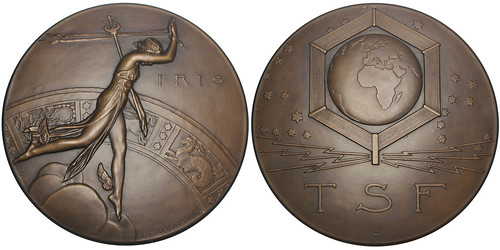
101128 | FRANCE. Télégraphie sans Fil [Radio] Art Deco bronze Medal. Issued 1927. The emergence of wireless or radio communication (99mm, 12h). By P. Dammann in Paris. IRIS, Iris striding right among the clouds, head lowered, holding trident-headed scepter and streamers; in background, zodiacal band with Scorpio, Sagittarius, and Capricorn / View of the Earth, focused upon Europe and Africa, surrounded by hexagonal, segmented antennae, the bottom segment of which is emitting radio waves; stars in the background, T S F [Télégraphie sans Fil = telegraph without wires] below. Edge: «cornucopia» MONETA 28. Jones, Art of the Medal, 423. Gem Mint State. Alluring bronze-brown surfaces, with a light matte nature. Likely one of the finest known of this small output in the larger (99mm) module, of which this is numbered (on the edge) as #28. One of the iconic and rarer Art Deco medallic works of the period. $895
Following the proof of the existence of electromagnetic waves by German physicist Heinrich Hertz in 1887, a flurry of other scientific minds turned to a new medium for study—the "airwaves." Guglielmo Marconi's invention of the radio, for which he won the 1909 Nobel Prize in Physics, furthered what would become a rapidly growing industry during the first three decades of the 20th century, as communication now need not be reliant upon the connection of wires. Here, Dammann captures this novel technology and pairs it with another movement indicative of its era—the refined, elegant, and geometric artistry that embodies Art Deco.
Gotta love it. A great Art Deco design. -Editor
To read the complete item description, see:
101128 | FRANCE. Télégraphie sans Fil [Radio] Art Deco bronze Medal.
(https://www.numismagram.com/product-page/101128)
Charles Darwin Medal
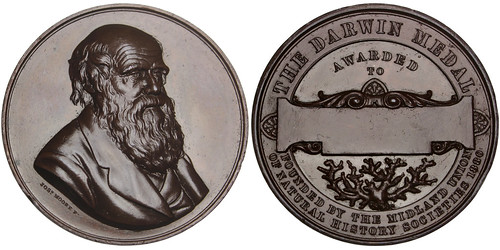
101150 | GREAT BRITAIN. Charles Darwin bronze Medal. Issued 1880 or later by the Midland Union of Natural History Societies for the Darwin Prize [unawarded] (44mm, 39.11 g, 12h). By J. Moore in Birmingham. Bust facing slightly right / THE DARWIN MEDAL / AWARDED TO / FOUNDED BY THE MIDLAND UNION OF NATURAL HISTORY SOCIETIES 1880, elaborate scroll left blank for engraving; branch of coral below. Edge: Plain. Choice Mint State. Rich red-brown surfaces, with a great deal of brilliance; a few subtle rim bruises are noted merely for completeness. Very rare and interesting. Compare to a slightly different Darwin medal contemporaneous with this one, struck for the Royal Society, which just realized a total of €1,020 (after the buyer's fee) in late May. $795
Very little can be located relating to the history of this medal as well as the number of specimens issued during the late 19th century, and they are missing from any public sales from the past two decades. An article from the 9 July 1887 issue of The Gardeners’ Chronicle (p. 51) reveals a brief history of the medal and its recipients up to that point:
“THE DARWIN MEDAL—At the annual meeting of the Midland Union of Natural History Societies, held on Wednesday, July 6, at Malvern, the Darwin Medal, which is this year set apart for Archæology, was awarded to Mr. Edward W. Badger, M.A., of King Edward’s High School, Birmingham, for his paper on “The Monumental Brasses of Warwickshire.” The adjudicators were the Very Rev. J. J. Stewart Perowne, D.D., Dean of Peterborough; M. H. Bloxham, Esq.; John Amphlett, Esq.; W. H. Duignan, Esq.; and J. A. Cossins, Esq. The adjudicators’ report speaks in high terms of the value and interest of the paper, and comments upon the care and ability evidenced in its preparation. The Darwin Medal was founded in 1880 by the Midland Union of Natural History and other scientific societies for the purpose of encouraging original research by members of the societies forming the Union. The scheme was submitted to Mr. Charles Darwin, and received his cordial approval. With his permission the prize was named after him. The subjects for which the Medal is awarded are geology, archæology, zoology, and botany. It has been previously gained four times—in 1881, by Mr. Edward Wilson, F.G.S., for geological research; in 1882, by Professor A. M. Marshall, D.Sc. (of Owen’s College), and Mr. W. P. Marshall, M.I.C.E., for their investigations into the life-history of the “Pennatulida;” in 1884, by Mr. W. B. Grove, B.A., for a monograph on the “Pilobolidæ,” and other botanical papers; and in 1885, by Mr. W. J. Harrison, F.G.S., for geological research. It was not awarded in 1883 or in 1886. The medal is a handsome one, the dies for which were engraved by Mr. Joseph Moore, of Birmingham. On the obverse is a finely executed bas-relief bust of Charles Darwin, and on the other a branch of coral, commemorative of an important research made by the great naturalist. This is the first time the Medal has been awarded to an archaeologist.”
The giants of science don't come much bigger than Darwin. Great medal. -Editor
To read the complete item description, see:
101150 | GREAT BRITAIN. Charles Darwin bronze Award Medal.
(https://www.numismagram.com/product-page/101150)
Sellafield and Chernobyl Medal.

101145 | GREAT BRITAIN & UKRAINE. Sellafield and Chernobyl cast silver Medal. Issued 1986. Fallout (29mm, 25.97 g, 3h). By M. Appleby. Representations of flora and fauna (tree, fish, and goat) affected by the impact of nuclear fallout and other airborne environmental disasters; all within vertical 'cat eye' border / FALLOUT / 1986 around horizontal 'cat eye' border. Edge: «4 hallmarks». BAMS 37, M10. Gem Mint State. Essentially as issued, with a pleasing prooflike nature, great luster, and some subtle toning. A powerful and rare piece, 1 of just 39 cast by the artist from hand engraved dies. $345
Produced in the aftermath of the Chernobyl disaster—a nuclear accident in the spring of 1986 near the city of Pripyat in Soviet Ukraine—this moving medal alludes to the impact of the radioactive fallout that touches aspects of life, be it flora or fauna. Due to wind patterns, areas in Northern Europe (like the artist's home country of Scotland) began to see an impact, with particles of caesium-137—a radioactive isotope that is a common product following a fission reaction of the primary "fuel," uranium-235—being scattered across the countryside. Likewise, the much closer Sellafield nuclear power plant, located in northern England near the border with Scotland, has had its own problematic history with contamination. This medal serves as a reminder of the shared experiences of everyone on the planet, and that what can affect one can affect everyone and everything.
Interesting and unusual piece - I hadn't seen this one before. -Editor
To read the complete item description, see:
101145 | GREAT BRITAIN & UKRAINE. Sellafield and Chernobyl cast silver Medal.
(https://www.numismagram.com/product-page/101145)
Jacques-Arsène d'Arsonval Medal

101143 | FRANCE. Jacques-Arsène d'Arsonval bronze Medal. Issued 1933. La maladie sera vaincue (80mm, 238.30 g, 12h). By P. Dammann at Arthus-Bertrand in Paris. PROFESSEVR A D'ARSONVAL / SON JVBILÉ MCMXXXIII, bust left / ??S?S ????T?S???? (the disease shall be overcome), in bas relief, nude female on knees, wearing cape and spearing three-headed serpentine hydra to right; RENAISSANCE FRANÇAISE. Edge: «triangle» BRONZE. Maier –. Gem Mint State. Olive-bronze surfaces, with an alluring matte nature. A great Art Deco design by one of the masters. $375
The inventor of his eponymous galvanometer, Jacques-Arsène d’Arsonval was a famous French physician and physicist who contributed greatly to the field of electrophysiology—the science that investigated the effects of electricity on organisms. The reverse of this medal alludes to the conflict between disease and the science to combat it.
I like this great Art Deco design. -Editor
To read the complete item description, see:
101143 | FRANCE. Jacques-Arsène d'Arsonval bronze Medal.
(https://www.numismagram.com/product-page/101143)
Napoléon I Medal
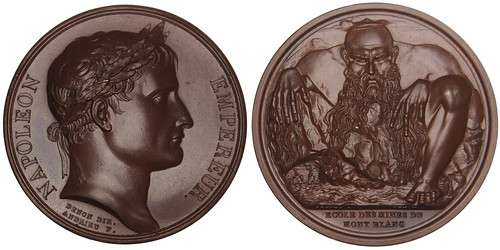
101171 | FRANCE. Napoléon I bronze Medal. Issued 1804. The establishment of the School of Mineralogy at Mont Blanc (39mm, 42.21 g, 12h). By B. Andrieu and N. G. A. Brenet in Paris. NAPOLEON EMPEREUR, laureate head right / Mont Blanc (as an old man of colossal size), crouching facing and lifting large rock under which two miners are working; in two lines in exergue, ECOLE DES MINES DU / MONT BLANC. Edge: Plain. Bramsen 471; Julius 1498; d'Essling 1121; Zeitz 34. Gem Mint State. Rich red-brown surfaces, with a great deal of brilliance remaining. Popular allegorical type. $495
One of the iconic types within the celebrated Neoclassical Napoleonic series, this medal features an expressive and intricate anthropomorphization of the mountain, presenting it as an old man, balding and with a rather robust, unkempt beard. As one travels down further from his face, the beard transforms into a waterfall in which fish swim. Under his right hand, two miners are at work—one hacks at the earth with an axe, while the other pushes a minecart.
Creepy and unusual design. -Editor
To read the complete item description, see:
101171 | FRANCE. Napoléon I bronze Medal.
(https://www.numismagram.com/product-page/101171)
Samuel Thomas Sömmering Medal

101109 | GERMANY Samuel Thomas Sömmering bronze Medal. Issued 1827. Commemorating the 50th anniversary of his doctorate (50mm, 77.50 g, 12h). By C. Pfeuffer & G. Loos in Berlin. S TH A SOEMMERRING NAT THORUNI D XXVIII IAN MDCCLV DOCT CREAT GOTTINGAE D VII APR MDCCLXXVIII, bare head right; serpent-entwined staff to right / ANATOMICORUM PRINCIPI ANIMAE ORGANA QUI APERUIT ARTIS VIRIQUE CULTORES D VII APR MDCCCXXVIII, view of a human brain from the top. Edge: Some staining, otherwise plain. Brettauer 1159; Sommer P-19; Joseph & Fellner 1030. Choice About Uncirculated. Reddish-brown surfaces, with some underlying brilliance in the fields; some scattered spots are noted throughout. Highly interesting anatomical type. $265
One of the most important German anatomists, Samuel Thomas Sömmering received his doctorate from the University of Göttingen in 1778, for which he described the organization of the cranial nerves. During his career, he investigated the brain and nervous system, as well as sensory organs and the lungs. Of particular note, he discovered the macula in the retina of the human eye. Given this intense focus on the nervous system as a whole, the choice of a human brain on this doctorate celebratory medal is quite appropriate.
The brainiest medal I've ever seen! -Editor
To read the complete item description, see:
101109 | GERMANY. Samuel Thomas Sömmering bronze Medal.
(https://www.numismagram.com/product-page/101109)
WAYNE'S NUMISMATIC DIARY: JUNE 7, 2020
One of my many projects lately has been organizing my numismatic ephemera collection. I was so proud of myself when I completed what I thought was the last of it - until I found three more boxes of stuff I'd overlooked. So I'm going through a second phase of sorting, organizing and prioritizing. Here are a few of the items I came across and thought I'd share.
Green's Numismatist's Reference and Check Book
 Ben Green of Chicago published Green's Numismatist's Reference and Check Book in 1902 and 1912 according to Charlie Davis' 1992 American Numismatic Literature. Pictured here is a leather version of the 1912 second edition along with two supplements. Is anyone aware of other editions or supplements? Supplements "A" and "B" cover coinage of 1902 and 1903 - were there annual supplements for all the intervening years between the first and second editions?
Ben Green of Chicago published Green's Numismatist's Reference and Check Book in 1902 and 1912 according to Charlie Davis' 1992 American Numismatic Literature. Pictured here is a leather version of the 1912 second edition along with two supplements. Is anyone aware of other editions or supplements? Supplements "A" and "B" cover coinage of 1902 and 1903 - were there annual supplements for all the intervening years between the first and second editions?
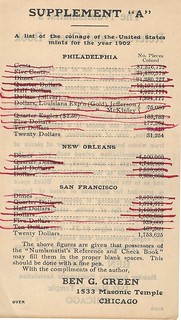
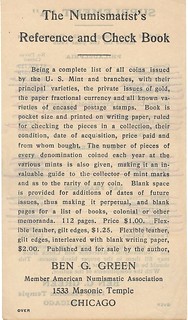
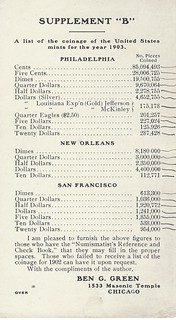
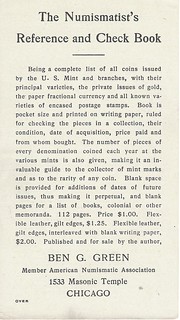
Whitman Coin Checklist
Whitman also had a checklist. Rather than carry their full coin folders with them, collectors could carry this handy checklist to record their wants. This one was heavily used by its owner. Does anyone else have one of these?
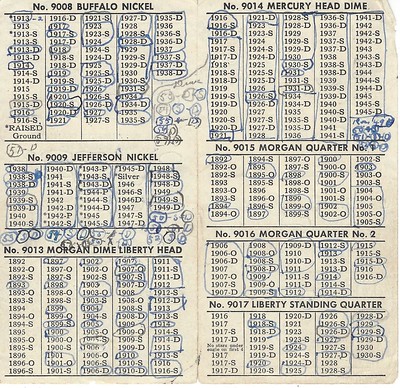

Someone I was certain would have some of these is researcher and author David Lange, who as it happens is just putting the finishing touches on a new book about Whitman products, the fourth of his books on coin boards, albums and folders. He kindly provided this sneak preview of the section on Whitman checklists. Thanks! -Editor
 "As a child collecting coins from circulation the author kept track of his growing collection by placing a tiny ink dot next to each corresponding line in his 1964 edition of Whitman’s Blue Book (A Handbook of United States Coins). Evidently, this practice was widespread, as many old coin guidebooks are found today with dots, dashes, checkmarks or cross-outs marking their owners’ progress. Evidently, Whitman knew that collectors were using its references in this manner, and in 1960 it published an actual pocket-size check book for that sole purpose. This bore the grand title Illustrated Check List and Record Book of United States and Canadian Coins: All Regular and Commemorative Issues Including Gold.
"As a child collecting coins from circulation the author kept track of his growing collection by placing a tiny ink dot next to each corresponding line in his 1964 edition of Whitman’s Blue Book (A Handbook of United States Coins). Evidently, this practice was widespread, as many old coin guidebooks are found today with dots, dashes, checkmarks or cross-outs marking their owners’ progress. Evidently, Whitman knew that collectors were using its references in this manner, and in 1960 it published an actual pocket-size check book for that sole purpose. This bore the grand title Illustrated Check List and Record Book of United States and Canadian Coins: All Regular and Commemorative Issues Including Gold.
"Like all Whitman coin products, it bore a four-digit Publisher Number. Originally this was No. 9091, but different numbers were assigned in later years as the booklet evolved. The idea was not original, as Chicago dealer Charles Green had produced his Mint Record and Type Table, United States Coins in 1936, widely used as a convenient check list in its own time. Whitman’s book, however, included mintages and a grade table with which collectors could check off the appropriate grade for a particular date/mint. This permitted them to know when a coin under consideration was a potential upgrade, and the record book has gone through many editions and format changes since 1960.
"The story of Whitman’s record book actually goes back some years earlier, as before it assumed book form the same concept was put out as a tiny pamphlet. A simplified product titled Check List for Whitman Coin Collectors, it was actually a listing of each date/mint to be found in each of the company’s Blue Folders. The coin series name and its corresponding folder’s Publisher Number appeared above the listing of dates/mints, but there were no mintages and no grade grid. Instead, users simply crossed out each entry as it was obtained, regardless of grade, though one could also place a tiny dot or check mark where the limited space allowed.The author’s collection includes examples of this check list utilized in each of these various ways.
"The earliest one seen dates from 1942, and the latest known is from 1964. All were folded over themselves as issued, and an unprinted area was provided below the words “For Sale By.” This permitted each shop owner to stamp or write his business name and address. Whitman got the idea for this feature from the coin boards published by J. Oberwise and Company, whose boards always had such a vendor block at the lower right of their backs. In addition to being useful in marking the progress of one’s collection, these lists subtly encouraged coin enthusiasts to acquire the additional folders not already owned, and they likewise reminded users from whom they could find both the folders and the coins to fill them."
Tim's Official Redback
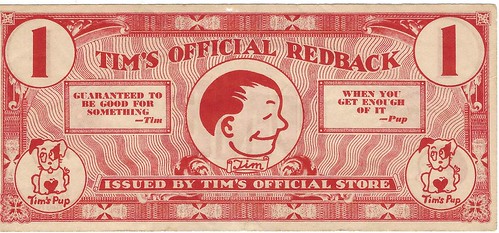

A Worthpoint article pictures a group of similar notes in denominations of 1, 5, 10 including one "Superman" Redback. They are described as 1940s toy money.
To read the Worthpoint articles, see:
VINTAGE SUPERMAN AND TIM'S OFFICIAL REDBACK TOY MONEY
(https://www.worthpoint.com/worthopedia/vintage-superman-tims-official-1751842549)
1940S SUPERMAN REDBACK TIM STORE PROMO CURRENCY NOTE LOT 1 5 10 DOLLAR VINTAGE
(https://www.worthpoint.com/worthopedia/1940s-superman-redback-tim-store-1731422365)
A March 6, 2015 Coin World article by Michele Orzano describes a different style piece sold by Heritage. -Editor
A Superman fan club scrip note sold for $28 in the Feb. 17, 2015, Heritage Internet Currency Auction.
More than 70 years ago a company called Tim Publications Inc. created a club for young children called the Superman-Tim Club. It was aimed at those who enjoyed the company’s Superman-Tim comics.
These comics were 6-inch by 9-inch booklets printed monthly. Each comic’s pages offered club members the opportunity to redeem “Redbacks” to buy Superman-Tim clothing items that were carried in department stores.
The first issue of Superman-Tim was published in 1942, shortly after Superman’s debut in Action Comics #1. Publication of the Superman-Tim comic ceased in 1950.
To read the Coin World article, see:
Superman-Tim scrip note from the 1940s sells for $28 in auction
(https://www.coinworld.com/news/precious-metals/superman-tim-scrip-note-from-the-1940s-sells-for-28-in-auction.html)
My piece is accompanied by a note stating "Groff + Wolf Co stamped on some." I found a Groff and Wolff men's clothing store in Lancaster, PA. I don't collect play money, but like any semi-numismatic item, these have a story to tell. Do any of our readers have a collection of them? -Editor
W. Elliot Woodward's Mt. Pleasant Apothecary Store Scrip
Numismatic bibliophiles know W. Elliot Woodward (1825-1892) of Boston as one of the top coin auctioneers of the 19th century.
As a collector of U.S. Civil War scrip I also knew him as the issuer of 5 and 20 cent notes of his pharmacy, the Mt. Pleasant Apothecary Store. Most of the notes available today are unissued remainders, but some were signed by Woodward himself and used in commerce. I searched for quite a while to find the ones below. I bought the 5 cent note from Claud Murphy at the 1991 ANA convention. I don't have a record of where the FACSIMILE note came from. It's is a reproduction on different paper than the originals, but I'm not sure who created it or when. Ideas anyone?

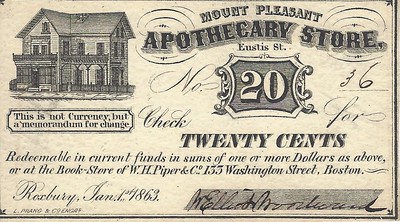
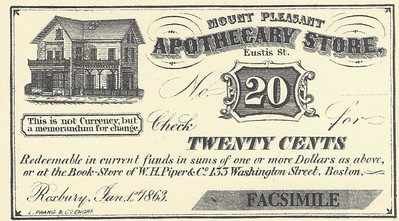
Numismatists Online
Moving to the late 20th century, on the left below is a flyer advertising Numismatists Online, an early internet site for running coin auctions. On the right is one of their ads from the July 1999 Numismatist. This was in the days before most dealers had web sites of their own. Even Heritage Rare Coin Galleries is listed as a seller.
I remember being in touch by email with the owner of the business, but I'm afraid I've lost his name and contact information. The domain name is unused today and up for sale. It was a very labor-intensive process in those days, with web pages being built by hand rather than being driven by databases and software. Dealers had to send the company all the information about their lots so the web pages could be custom built.

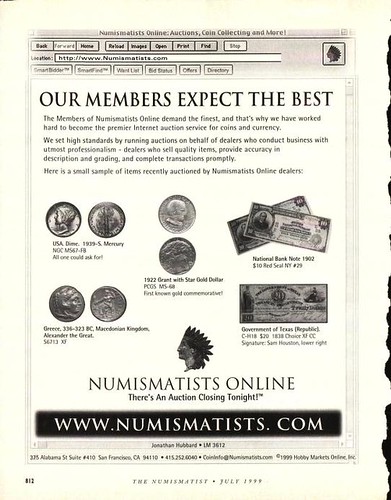
Can anyone tell us more about the business and what became of it?

A 1929 ST. GAUDENS DOUBLE EAGLE
Heritage provided this writeup of a rare U.S. gold coin that has been moved to the August American Numismatic Association sale from the cancelled Summer FUN show. -Editor
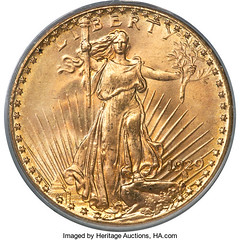
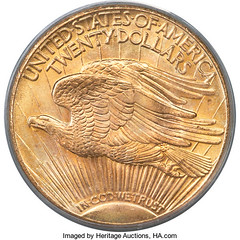
Owning a $20 Saint Gaudens gold coin from the 1920s is typically a very achievable goal for many coin collectors given the large quantities that were produced at the Philadelphia Mint in 1924, 1927, or other common years of that decade. However, when you get to the last year of that decade--1929--you reach a sudden stumbling block. Despite the fact that just over 1,700,000 coins were minted, less than 330 pieces total have been certified by PCGS and NGC.
Very few of these coins from 1929 are available to collectors today, and this is where the $20 Saint series becomes very tough to obtain. The last few pieces of the series--1929, 1930-S, 1931, 1931-D, and 1932--are all rarities and generate spirited bidding on the rare occasions that they come up for bid.
Heritage Auctions will be offering a 1929 $20 Saint graded a lofty PCGS MS65 in the July Summer FUN Sale #1317. With similar coins selling in the $60,000 to $70,000 range in the past, elite collectors will be ready to compete with one another to add this rare date to their set! Whether you are working on a date and mintmark set of Saint Gaudens Double Eagles or simply appreciate the history of a scarce date 20th Century gold coin, this would be a wonderful piece for an advanced coin cabinet.
To see the coin images online:
Coin Index Numbers: (NGC ID# 26GL, PCGS# 9190)
(https://coins.ha.com/itm/saint-gaudens-double-eagles/double-eagles/coming-soon-pcgs-9190-/p/1318-22014.s)
ANTI-COUNTERFEITING UPDATE
Here's an update on recent activities of the Anti-Counterfeiting Educational Foundation (ACEF). -Editor
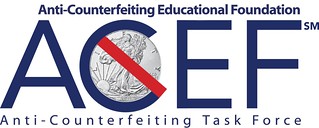 A fraudulent advertisement for bullion coins on Facebook, fake encapsulation holders and requests for expert help from federal agencies kept the nonprofit Anti-Counterfeiting Educational Foundation (www.ACEFonline.org) busy during May 2020.
A fraudulent advertisement for bullion coins on Facebook, fake encapsulation holders and requests for expert help from federal agencies kept the nonprofit Anti-Counterfeiting Educational Foundation (www.ACEFonline.org) busy during May 2020.
“Among the cases we’re investigating is the sale of ten fake one-ounce silver American Eagles. They were unsuspectingly purchased by someone who responded to an advertisement that popped up while he was checking his Facebook account. All ten coins he received in response to his order were counterfeit,” said Doug Davis, Director of the ACEF Anti-Counterfeiting Task Force.
"The victim provided us pictures showing one coin being cut in half to reveal it was composed of base metal, not silver. We have provided information about the seller and the potential manufacturer to the U.S. Treasury Office of Inspector General, Customs and Border Protection (CBP) and to the Secret Service,” explained Davis, a former Texas police chief.

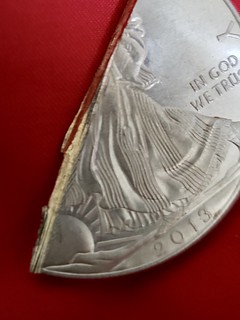
Another case ACEF officials received in May involved counterfeit coins housed in fake Numismatic Guaranty Corporation (www.NGCcoin.com) and Professional Coin Grading Service (www.PCGS.com) encapsulation holders. The victim spent $8,000 responding to an offer made on Mercari, an e-commerce platform. ACEF contacted NGC and PCGS to verify the holders were not genuine, and the information has been provided to federal law enforcement.
ACEF, which operates solely on donations from the public, cautions that the number of websites offering counterfeits for sale continues to grow.
“Analysis indicates that many of the websites are staying operational for only a few days and then shutting down, making it difficult to trace. However, we have been able to determine they just turn around and open a new website under a different name. We have also been able to identify other third party platforms that are being used to distribute counterfeit coins,” said Davis.
“We have been requested by CBP to send a list of websites selling counterfeit coins and precious metals so their investigators can use this intelligence information to identify manufacturers and importers. CBP and Secret Service have several cases being worked in the Los Angeles/ Long Beach area, and volunteers from the ACEF Anti-Counterfeiting Task Force have provided expert assistance there,” he explained.
ACEF volunteers also are providing expert help to Secret Service agents in San Francisco who are working on counterfeiting cases there and to CBP agents investigating seized numismatic fakes in the El Paso, Texas area.
“Remember, if you don’t know precious metals, you’d better know a reputable seller, such as experts affiliated with the Accredited Precious Metals Dealer program (www.APMDdealers.org),” said Davis.
Collectors, dealers and the general public are encouraged to report any counterfeits or counterfeit fraud activity by email to Davis at the Anti-Counterfeiting Educational Foundation at Doug@ACEFonline.org.
The efforts of the nonprofit Anti-Counterfeiting Educational Foundation and its Anti-Counterfeiting Task Force are supported entirely by donations. Monetary contributions may be made online at www.ACEFonline.org/donate or by check made out to ACEF and mailed to ACEF, 28441 Rancho California Rd., Ste. 106, Temecula, CA 92590. For additional information about donating, contact ACEF Executive Director Bob Brueggeman at info@ACEFonline.org.
To read the complete article, see:
Counterfeiting Battles Continued in May
(https://acefonline.org/counterfeiting-battles-continued-in-may/)
ASSAY COMMISSION MEDALS
Steve Roach published a Coin World article May 30, 2020 about a great series of U.S. Mint medals - the Assay Commission medals. Here's an excerpt. -Editor
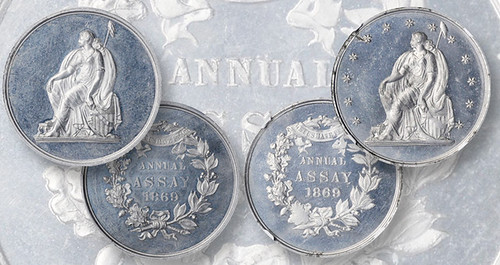
The United States Assay Commission no longer exists, but is remembered by a series of medals designed by many of the U.S. Mint’s top talents in the 19th and 20th centuries. The commission’s purpose was to supervise annual testing of gold, silver, and other metals in the Mint’s coins to make sure that they were struck in accordance with specifications. Members, among them many collectors, received a specially designed medal for their participation. The final medal in 1977 was sold to the public.
A number of these medals were offered in the Stack’s Bowers Galleries March 18 auction of the Richard Jewell Collection.
To read the complete article, see:
Market Analysis: Collectors love design diversity in Assay Commission medals
(https://www.coinworld.com/news/us-coins/market-analysis-collectors-love-design-diversity-in-assay-commission-medals)
The article linked to a nice 2016 Coin World article by Joel Orosz on the R.W. Julian book Medals of the United States Mint: The First Century, 1792-1892. -Editor
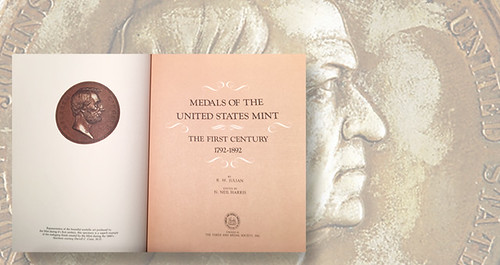
He divides all the medals produced by the U.S. Mint in its first century into 14 classes, starting with those made for the members of the annual Assay Commission, ending with Religious and Fraternal Medals, and covering topics such as Indian Peace Medals and Life Saving Medals in between.
Julian illustrates and describes each medal, obverse and reverse; gives each a discrete catalog number; identifies its engraver; lists its size and composition (gold, silver, bronze); provides a brief history; and reveals if the original dies still repose at the Mint (making restrikes a possibility). All of this is invaluable to the researcher and collector, but the most fascinating parts of the book occur when Julian exposes the ample dirty laundry that always accumulated at the 19th century Mint.
Consider the fiasco surrounding MI-19, the Military gold medal honoring Brig. Gen. Eleazer Ripley’s heroics during the War of 1812. Congress authorized the medal on Nov. 3, 1814. The Mint took almost 24 years to strike it! Julian recounts the entire comedy of errors, starting with the Mint’s foot-dragging (not until 1821 did engraver Moritz Furst prepare the reverse). Ripley added to the problem by stubbornly refusing, for five long years, to provide his own portrait for the obverse. Then accusations that Ripley hadn’t participated in the battles mentioned on the reverse stalled progress for years until proven false. Finally, Chief Coiner Adam Eckfeldt had to pay for the gold used to strike Ripley’s medal out of his own pocket, so it wasn’t until 1838 — only a year before he died — that Ripley at last received his tribute, and Eckfeldt got reimbursed (through a special act of Congress)! That is just one case; a whole series of stories documents the personal profiteering of Eckfeldt’s successor, Franklin Peale, who pocketed proceeds from medals made by Mint employees, on Mint time, with Mint material, using Mint presses.
To read the complete article, see:
Book on first century of U.S. Mint medals a classic
(https://www.coinworld.com/news/precious-metals/book-on-first-century-of-us-mint-medals-a-classic.html)
THE MEDALLIC ARTISTRY OF ERIK LINDBERG
Stack's Bowers Senior Numismatist and Cataloger Jeremy Bostwick published a blog article June 4, 2020 on the medallic work of Johan Erik Lindberg. -Editor
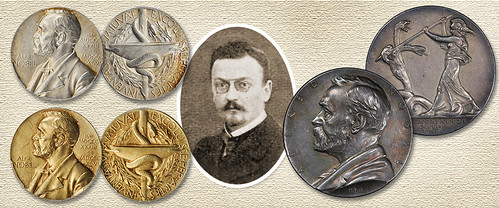
In the world of medallic art, France may come to mind for its association with some of the most skilled and elegant craftsmen and their work, especially during the late 19th and early 20th centuries. Any survey of medals and coins from this period will show the beauty that the Art Nouveau and Art Deco movements provided to the numismatic scene. However, production of artistic medals was not limited to France. Although Sweden is not as often represented in collections and literature devoted to numismatic art, it is not due to a lack of exceptional material produced by incredible sculptor/engravers. One such artist was Johan Lindberg, most commonly known by his middle name, Erik.
Born in Stockholm on the final day of 1873, Erik grew up with an artistic presence, as his father, Johan Adolph, was a famous sculptor and engraver of medals, even serving as a professor at the Royal Swedish Academy of Fine Arts. Focused intently upon his craft, Erik split most of the 1890s training at his father's studio and studying at the Academy. Following his graduation from the Academy, he earned a scholarship for study in Paris where he was greatly influenced by the styles of such luminaries as Louis-Oscar Roty and Jules-Clément Chaplain.
It was during this period that he was tasked with the creation of the medals to be awarded for the newly established Nobel Prizes, one of the first of his numismatic contributions. While the reverse designs of these majestic medals vary based upon the subject matter celebrated, the obverses all display the same classical rendition of Alfred Nobel, the creator of the trust used to finance the prizes. Outside of the Peace Prize, presented instead in Oslo, and the Economics Prize, created much later by the Sveriges Riksbank, Lindberg's renditions continue to be used for the prize medals as well as the medals presented to the nominating committees. Though the actual prize medals are almost never encountered in the market, the nominating medals do appear at auction and have become quite popular as they are generally as close as one can realistically get to an actual prize medal.
Lindberg's medallic portfolio doesn't end at the Nobel Prize and Nominating Committee medals, as he actively produced some of the most elegant and expressive medals of the period, even designing some of the circulating gold denominations for the Swedish mint. His style presents a strong background in Art Nouveau, yet also offers hints of Art Deco and a definitive nod to the reinvigorated allure of Neoclassicism. During the first half of the 20th century, he created a wealth of timeless pieces for the collector of fine medallic art that is still rather unexplored by the community.
Our June Collectors Choice Online (CCO) auction offers a number of Nobel medals from various years relating to the nominating committee on Medicine, as well as an iconic silver medal for Alfred Nobel himself on the 30th anniversary of his death in 1926. On this rather rare piece, Lindberg's unique style is on full display, with a representation of Athena/Minerva spearing a three-headed serpentine hydra. Discover these wonderfully classic and distinguishing works by one of medallic art's lesser-mentioned master engraver/sculptors in our CCO today!
To read the complete article, see:
The Timeless Artistry of Erik Lindberg
(https://www.stacksbowers.com/News/Pages/Blogs.aspx?ArticleID=erik-lindberg-world-cco-coins)
MORE ON CIVIL WAR ALLOTMENT CHECKS
In February we discussed Civil War Allotment checks. The Delancey Place newsletter published a book excerpt on June 1st detailing how the allotment check system was devised and implemented by Theodore Roosevelt Sr., father of President Teddy Roosevelt. -Editor
 Theodore Roosevelt, Sr., father to the future president, spent his years in the Civil War persuading soldiers to set aside voluntary pay deductions for family support, a novel concept in war.
Theodore Roosevelt, Sr., father to the future president, spent his years in the Civil War persuading soldiers to set aside voluntary pay deductions for family support, a novel concept in war.
"Already, in these early days of war, millions of government dollars were flowing through the pockets of Union soldiers and into the hands of sutlers, who infested military camps, hawking bottles of liquor hidden in loaves of bread. The sutlers charged such exorbitant prices that their customers soon had no money left to send home to their families. It was to right this wrong that Theodore Senior set off to Washington, and, conquering his natural distaste for politics, began to lobby for remedial legislation.
"With two colleagues, he drafted a bill for the appointment of unpaid Allotment Commissioners, who would visit all military camps and persuade soldiers to set aside voluntary pay deductions for family support. This proposal, which eventually became standard military practice, seemed eccentric, if not downright suspect, in 1861, as a family friend recalled many years later:
For three months they worked in Washington to secure the passage of this act -- delayed by the utter inability of Congressmen to understand why anyone should urge a bill from which no one could selfishly secure an advantage. When this was passed he was appointed by President Lincoln one of the three Commissioners from this State. For long, weary months, in the depth of a hard winter, he went from camp to camp, urging the men to take advantage of this plan; on the saddle often six to eight hours a day, standing in the cold and mud as long, addressing the men and entering their names. This resulted in sending many millions of dollars to homes where it was greatly needed, kept the memory of wives and children fresh in the minds of the soldiers, and greatly improved their morale. Other States followed, and the economical results were very great.
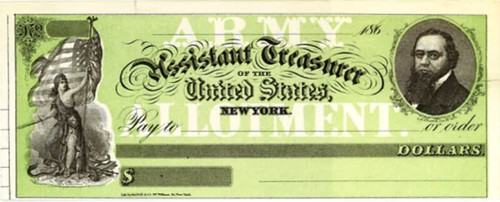
To read the complete article, see:
WAR SERVICE, THEODORE SR., AND THEODORE JR. -- 6/01/20
(https://delanceyplace.com/view-archives.php?p=4096)
On a related note, wrap your head around this - the last person receiving a pension from the U.S. Civil War died just last week! -Editor
Irene Triplett, the last person receiving a pension from the U.S. Civil War, has died at the age of 90.
Ms. Triplett’s father, Mose Triplett, started fighting in the war for the Confederacy, but defected to the North in 1863. That decision earned his daughter Irene, the product of a late-in-life marriage to a woman almost 50 years his junior, a pension of $73.13 a month from the Department of Veterans Affairs.
Ms. Triplett, who suffered from mental disabilities, qualified for federal financial support as a helpless adult child of a veteran. She died Sunday from complications following surgery for injuries from a fall, according to the Wilkesboro, N.C., nursing home where she lived.
Pvt. Triplett enlisted in the 53rd North Carolina Infantry Regiment in May 1862, then transferred to the 26th North Carolina Infantry Regiment early the following year, according to Confederate records. He fell ill as his regiment marched north toward Gettysburg and remained behind in a Virginia military hospital.
He ran away from the hospital, records show, while his unit suffered devastating losses at Gettysburg. Of the 800 men in the 26th North Carolina, 734 were killed, wounded or captured in the battle Pvt. Triplett missed.
Now a deserter, he made his way to Tennessee and, in 1864, enlisted in a Union regiment, the 3rd North Carolina Mounted Infantry.
Pvt. Triplett married Elida Hall in 1924. She was 34 when Irene was born in 1930; he was 83. Such an age difference wasn’t rare, especially later, during the Great Depression, when Civil War veterans found themselves with both a pension and a growing need for care.
Pvt. Triplett died in 1938 at age 92, days after attending a reunion of Civil War veterans, attended by President Franklin Roosevelt, on the fields of Gettysburg.
To read the complete article (subscription required), see:
Last Person to Receive Civil War-Era Pension Dies
(https://www.wsj.com/articles/last-person-to-receive-a-civil-war-era-pension-dies-11591141193)
To read the earlier E-Sylum articles, see:
QUERY: A BLANK CIVIL WAR PAYCHECK
(https://www.coinbooks.org/v23/esylum_v23n05a13.html)
CIVIL WAR ALLOTMENT CHECKS
(https://www.coinbooks.org/v23/esylum_v23n06a11.html)
TRAVERSE DOLLARS
I didn't get a chance to mention this one earlier; I discovered it via the News & Notes newsletter from the Society of Paper Money Collectors (Volume V, Number 49, May 26, 2020). -Editor

During the Great Depression, some banks were closing temporarily and others failing completely. There was little money in the hands of the people, and given the uncertainty about their prospects of getting more of it, people tended to hoard what little they had. The short supply of U.S. dollars in the 1930s meant there was a need to come up with another way for trade to keep the economy going -- leading to the idea of local currencies, known across the country as Depression scrip.
In effect, it was a local bartering system, easier than exchanging goods or services, and used across a broad base of stores and services. And here this region, residents traded Traverse Dollars.
Local historian Richard Fidler notes the use of scrip was encouraged by no less than President Franklin Roosevelt. “The purpose was to get people spending again, not just hide money under the mattress,” he says.
Fidler explains they were issued in 1934 and could be redeemed at many Traverse City businesses in exchange for goods. At one point, local teachers were even paid in scrip, since there was no other money available for them.
So what were the stamps all over the backs of Traverse Dollars for?
According to DepressionScrip.com, the fact that there was little money in the hands of the people and there was great uncertainty about the prospects of getting more of it, people tended to hoard whatever money they did have. So to ensure wide distribution and use, the dollars had to be used on a weekly basis or they would lose value.
So the stamps were a way to make sure the Traverse Dollars were circulated. According to Cathy Schmitt, who first brought them to The Ticker’s attention, the money would decay by two cents a day unless you put a two-cent stamp on it and signed and dated it. So the incentive was to spend as fast as you could, she says.
The article also discusses a 2005 effort that created a similar community currency called Bay Bucks. -Editor
To read the complete article, see:
When Northern Michigan Bought Things With Traverse Dollars
(https://www.traverseticker.com/news/when-northern-michigan-bought-things-with-traverse-dollars/)

THE DUELING DUAL BANKNOTES OF LIBYA
Coins and paper money often find themselves in the middle of political struggles. A June 4, 2020 Coin Update article by Michael Alexander discusses the situation in Libya where two different controlling factions are printing banknotes. Here's an excerpt - see the complete article online for excellent graphics detailing the differences in the notes. -Editor

A large consignment of Libyan banknotes with a face value of one billion U.S. dollars and seized off the coast of Malta in September 2019 remain in a stalemate between U.S. and Russian authorities. The U.S. State Department reiterated on Friday the 29th May that they commend the seizure by Maltese authorities of $1.1 billion of “counterfeit Libyan currency” en-route to the North African country. However, a spokesman for Russia’s foreign ministry said on Saturday the 30th May in response to U.S. claims that the banknotes, headed for the Libyan Central Bank headquartered in Benghazi, are not counterfeit. The consignment of banknotes in denominations of 50 dinars (U.S. $70.50) and 20 dinars (U.S. $28.20) was seized and confiscated, and the U.S. State Department also cites them as contributing to supporting the Libyan National Army, who control roughly half of the country.
After the Libyan revolution which saw the violent ouster of strongman Muammar Gaddafi in 2011, the U.S. government and many European countries have supported the UN-recognised Government of National Accord (GNA) situated in Tripoli, which they have regarded as the country’s legitimate successor. An alternative faction within Libya headed by Field Marshal Khalifa Haftar has retained control of half of the country with its seat of government situated in Benghazi. It is this government or authority which the Russian Foreign Ministry admits these notes were headed for.
Libyan banknotes issued by the Tripoli location are printed in the United Kingdom in denominations of 1, 5, 10, 20, and 50-dinars. Washington has asked the head of the Government of National Accord and Central Bank in Tripoli to officially declare the alternative currency printed in Russia and issued from Benghazi to be illegal.
To read the complete article, see:
Libya: Dinar banknotes printed in Russia declared counterfeit by U.S. State Department
(http://news.coinupdate.com/libya-dinar-banknotes-printed-in-russia-declared-counterfeit-by-u-s-state-department/)
COUNTERFEITS IN MILWAUKEE AND MINNEAPOLIS
Here are three recent stories of counterfeit bills. Two are business as usual and not typically worth discussing. But they set context for the third, which is devastating. -Editor
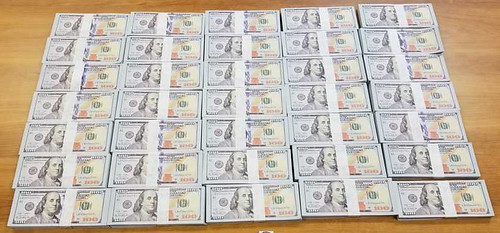
U.S. Customs and Border Protection agents say they seized more than $351,000 in counterfeit $100 bills in Milwaukee.
According to a press release, the seizure was made May 27 at the Express Consignment Operation facility.
Agents said the fake bills were shipped from Shanghai, China, and headed to a residence in Milwaukee.
In all, the shipment contained 3,515 counterfeit $100 bills totaling $351,500.
Investigators said the fake money was made of poor material, missing required watermarks, had no red and blue embedded fibers, each bill had the same serial number and there were Chinese letters on the back.

To read the complete article, see:
Milwaukee customs officials seize $351K in counterfeit $100 bills
(https://www.wisn.com/article/milwaukee-customs-officials-seize-dollar351k-in-counterfeit-dollar100-bills/32749114#)
Those are very poor counterfeits that shouldn't have fooled anyone, but fakes of all quality levels keep showing up in commerce, creating trouble. Over in Minneapolis, it was reported that a $20 bill believed to be fake led to the arrest that killed George Floyd. Here's an excerpt from a June 3, 2020 USA Today story. -Editor
Counterfeit bills allegedly circulated in the neighborhood around Cup Foods before a reported $20 forgery led to George Floyd's death in police custody on Memorial Day.
"I've seen my share of counterfeit bills," said P.J. Hill, a resident of the neighborhood, community leader and member of the Worldwide Outreach for Christ Ministries across the intersection from Cup Foods, where the report of the fake bill was made to police.
Two nearby business owners said they did not have a problem with counterfeits or know they were an issue.
Floyd allegedly used a counterfeit bill to buy cigarettes at the convenience store last week. The clerk reported it to police, a step that management described as store policy in Facebook posts.
Four police officers arrived for what is now a notorious arrest, captured on video by bystanders. Police officer Derek Chauvin held his knee on Floyd's neck for more than eight minutes, and Floyd was declared dead shortly thereafter.
"It went from a counterfeit bill to a man being killed to millions of people around the nation just hurting," Hill said. "Then to people being angry and responding in a militant way and destroying, burning cities. Then to a grieving and trying to protest.
"You just think about that, all from a counterfeit bill," Hill said.
To read the complete article, see:
What we know about George Floyd's death and alleged counterfeit money in Minneapolis
(https://www.usatoday.com/story/news/nation/2020/06/03/what-we-know-fake-currency-and-george-floyds-death-minneapolis-counterfeit-police/3137162001/)
That $20 bill may be in an evidence locker today, but whether it's actually fake or not is beside the point. Even when the words "To counterfeit 'tis death" were printed on bills I don't think that sentence was ever carried out. -Editor
Mark McCoy, a white man and an archaeologist and associate professor at Southern Methodist University in Dallas, Texas, was arrested in Massachusetts in 1994 for the same charge as Floyd - allegedly spending with a fake $20 bill.
McCoy, then a white 18-year-old, spent a night in jail, the charge was dropped after a six-month probationary period and he went on to be a successful university professor.
He recounted how when he left the restaurant, police officers picked him up.
He maintains he didn't know the bill he had used was fake and that anyone could accidentally use counterfeit money.
'This could happen to anyone.'
'George Floyd and I were both arrested for allegedly spending a counterfeit $20 bill,' he tweeted.
'For George Floyd, a man my age, with two kids, it was a death sentence.
To read the complete article, see:
Professor says his 'white privilege' meant his own arrest for trying to pay with a counterfeit $20 bill is 'a story I sometimes tell at parties' while for black man George Floyd it was a 'death sentence'
(https://www.dailymail.co.uk/news/article-8384791/Professor-says-arrest-fake-bill-different-George-Floyds-white-privilege.html)
This story will continue to play out for a long time. Meanwhile though, the store owner walked back their policy of calling police in these situations. -Editor
The Minneapolis corner market where a store clerk called police on George Floyd over an alleged fake $20 bill before his fatal arrest will no longer call police when they suspect counterfeit money, unless the situation turns violent, Cup Foods' owner Mahmoud Abumayyaleh told Inside Edition.
He also said the clerk working May 25 was inexperienced and called police on Floyd after the bill he used to buy a pack of cigarettes was flagged by a money-counting machine as potentially counterfeit.
But Abumayyaleh told Inside Edition that "most of the time when people present a counterfeit bill, they don't even know it's fake."
Ten days after Floyd's death, the store remains boarded up and the nation continues to mourn.
"People want answers, people want justice. George Floyd didn’t deserve to die," Abumayyaleh said.
To read the complete article, see:
George Floyd Was a Regular at Store That Called 911 and May Not Have Known Bill Was Possibly Fake, Owner Says
(https://www.insideedition.com/george-floyd-was-a-regular-at-store-that-called-911-and-may-not-have-known-bill-was-possibly-fake)
CAMBODIA PLANS TO LIMIT U.S. SMALL NOTE USE
A June 1, 2020 Coin Update article by Michael Alexander discusses Cambodia's plan to reduce use of small-denomination U.S. notes. -Editor
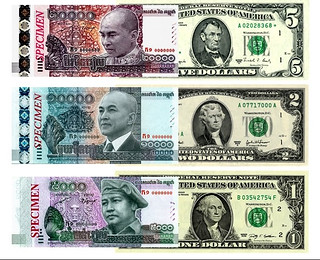 The National Bank of Cambodia has launched a plan (28th May) in which they are asking commercial banks and microfinance institutions to send it their smallest U.S. dollar banknotes to their offices for processing and transporting outside the country. In an effort to withdraw these smaller U.S. notes from commerce and support their currency, the Riel, The National Bank cited the notes are difficult and costly to manage in terms of processing and transport.
The National Bank of Cambodia has launched a plan (28th May) in which they are asking commercial banks and microfinance institutions to send it their smallest U.S. dollar banknotes to their offices for processing and transporting outside the country. In an effort to withdraw these smaller U.S. notes from commerce and support their currency, the Riel, The National Bank cited the notes are difficult and costly to manage in terms of processing and transport.
Speaking at the meeting, National Bank of Cambodia Director-General Chea Serey commented the National Bank confirmed they found the three smallest denominations of one, two and five U.S. dollar banknotes challenging to manage and conceded there is little demand for the overall in the Cambodian economy. Currently, the official National Bank exchange rate of one U.S. Dollar equals just over 4100 Riels, and as such, 5000 Riel notes could easily replace one dollar banknotes which routinely circulate. An updated series of the most commonly used riel banknote denominations were issued from 2013 to 2018, and Riel coins are seldom used.
The National Bank confirmed there would be a three-month deadline beginning from the 1st June for commercial Banks and Microfinance institutions to collect their supply of these notes and return them to National Bank central offices. Here, they will be processed one final time and transported outside the country to additional destinations.
In the last six months, the riel has depreciated noticeably against the U.S. dollar and with the current economic slow-down worldwide due to the pandemic arising from the spread of the Wuhan-strain of COVID-19, the downward spiral has continued.
To read the complete article, see:
Cambodia: National Bank unveils plan to limit use of $1, $2, and $5, U.S. dollar banknotes from domestic transactions
(http://news.coinupdate.com/cambodia-national-bank-unveils-plan-to-limit-use-of-1-2-and-5-u-s-dollar-banknotes-from-domestic-transactions/)
MONEY, BANKING AND DOUBLE-ENTRY BOOKKEEPING
This week I came across this 2019 article about the revolutionary impact of one aspect of money and banking - double-entry bookkeeping. Suppress your yawns and read the complete article which touches on the Medici Bank, Leonardo da Vinci, the divine proportion, Renaissance mathematics, Josiah Wedgwood, Bill Gates and Steve Jobs. Here's an excerpt. -Editor
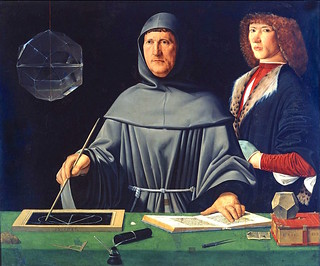 Each of those innovations changed human life in such fundamental ways that, once humanity had them we incorporated them (and the products and activities they brought in) into our daily lives to such an extent that we no longer gave them any more thought. Their fundamental role became no more remarkable than the presence of air and water.
Each of those innovations changed human life in such fundamental ways that, once humanity had them we incorporated them (and the products and activities they brought in) into our daily lives to such an extent that we no longer gave them any more thought. Their fundamental role became no more remarkable than the presence of air and water.
The same is true of more recent innovations, such as radio, the telephone, computers, the Internet, laptops, and mobile phones. To those of us who lived through at least some of those innovations, we still think of them as life-changing developments. But ask anyone of school age and it is clear that to them, all of those technologies are just part of the everyday environment. Nothing remarkable. It is a measure of the greatness of any innovation that completely transforms the way we live, that before long we no longer recognize how profound and remarkable it is.
Time, then, to take a fresh look at double-entry bookkeeping.
The benefit of keeping detailed records of financial transactions was recognized back in ancient times. For example, in ancient Rome the first emperor, Augustus, created imperial account books and established a tradition of publishing data from them. While Augustus’ primary purpose may have been propaganda—to publicize his personal spending—he made use of the accounts to plan projects and think about how the empire was managed. According to historian Jacob Soll in his excellent book The Reckoning, Augustus’ attention to the accounts enabled Rome to flourish.
But the beginnings of modern bookkeeping came much later, in the emerging city-states of northern Italy in the eleventh century, where the Crusades sparked a massive growth in commercial activity. As trade flourished, merchants in Florence and Venice, in particular, developed a method of accounting that became known as bookkeeping alla veneziana (“the Venetian method”).
In their ledgers, the Venetian merchants listed debits and credits in two separate columns. As Pacioli subsequently explained in Summa, this was the key to the new form of bookkeeping: “All the creditors must appear in the ledger at the right-hand side, and all the debtors at the left. All entries made in the ledger have to be double entries—that is, if you make one creditor, you must make someone debtor.” Today, we call this “double-entry bookkeeping.”
One important benefit of this system is it provides a built-in error detection tool; if at any moment in time the sum of debits for all accounts does not equal the corresponding sum of credits for all accounts, you know an error has occurred.
In Florence, in the fifteenth century, the bank run by the Medici family adopted double-entry accounting to keep track of the many complex transactions moving through accounts. This enabled the Medici Bank to expand beyond traditional banking activities of the time. It started opening branches in different locations, offered investment opportunities, and made it easy to transfer money across Europe using exchange notes that could be bought in one country and redeemed in another. This growth allowed them to dominate the financial world at a time when Florence was the center of the world for trade and education.
Looking back, we see that Venetian bookkeeping proved to be an ideal system for generating the financial statements that were required for the modern industrialized world. It could accurately record capital and income (as required by law and investors), it could distinguish between private expenses and corporate costs, and it could produce data that helped to evaluate past investment decisions.
It doesn’t get more relevant and important to today’s world than that.
To read the complete article, see:
HOW DOUBLE-ENTRY BOOKKEEPING CHANGED THE WORLD
(https://www.mathvalues.org/masterblog/2019/4/26/how-double-entry-bookkeeping-changed-the-world)
WHY STAMP COLLECTING IS BACK IN VOGUE
Cole Hendrickson writes:
"While not related to numismatics, there was an interesting article in this weekend’s issue of the Wall Street Journal about stamp collecting. Much of what is said could also be applied to numismatics."
True. I saw that piece. We've reported on the emerging trend before. Here's an excerpt. Thanks. -Editor

 GORGING ON HBO in Washington, D.C., while waiting for the city to unlock itself, my eye wandered from TV to the media cabinet shelf where my long-forgotten stamp albums sat. An inveterate traveler now marooned by pestilence, I began leafing through them, every postmark a childhood touchstone: The Belgian king, dyed an unflattering rose, that I had nicknamed “pink head.” The Czech hockey team that seemed sad to be trapped behind their Iron Curtain. The tiny Laotian mahout atop his enormous elephant sparked dreams of jungle journeys across Southeast Asia. Each stamp was a ticket to a destination I would, and did, later visit.
GORGING ON HBO in Washington, D.C., while waiting for the city to unlock itself, my eye wandered from TV to the media cabinet shelf where my long-forgotten stamp albums sat. An inveterate traveler now marooned by pestilence, I began leafing through them, every postmark a childhood touchstone: The Belgian king, dyed an unflattering rose, that I had nicknamed “pink head.” The Czech hockey team that seemed sad to be trapped behind their Iron Curtain. The tiny Laotian mahout atop his enormous elephant sparked dreams of jungle journeys across Southeast Asia. Each stamp was a ticket to a destination I would, and did, later visit.
After an absorbing afternoon, I wondered if a revival is due for this fusty pastime where history, graphic design and exotic landscapes commingle on a bit of sticky perforated paper.
Scott English, executive director of the nonprofit American Philatelic Society (APS) that serves as a resource for stamp collecting and collectors, says online search results listing the APS have roughly doubled to 1.2 million since March. Gerard McCulloch, whose blog Punk Philatelist explores stamps and pop culture, has observed more millennials and women taking up the hobby in the pandemic. Both men think stamp collecting’s nondigital nature is compelling. “It’s a very analog way to spend your day,” said Mr. English.
To read the complete article (subscription required), see:
Why Stamp Collecting Is Suddenly Back in Vogue
(https://www.wsj.com/articles/why-stamp-collecting-is-suddenly-back-in-vogue-11591358415)
To read earlier E-Sylum article, see:
MILLENNIALS AND STAMP COLLECTING
(https://www.coinbooks.org/v23/esylum_v23n15a44.html)
WEIRD THINGS PEOPLE COLLECT
In the if-your-spouse-thinks-coin-collecting-is-bad-show-them-this! department, here's an article on "43 People Who Collect The Weirdest Things Ever". Thanks to Martin Kaplan for passing this along. -Editor
Meet the people who possess some of the world’s largest collections of the most bizarre things. I honestly had a “why dude, why?” moment with this one. Several of it, actually.

Back scratchers
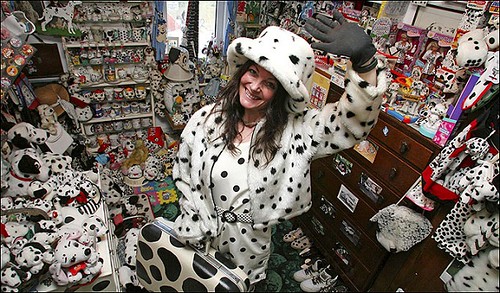
Dalmatians
Martin adds:
"#29 Airline barf bags is my favorite."
Everyone's least favorite has to be a tie between bellybutton fluff and toenail clippings, which make celebrity hair clippings seem almost normal.
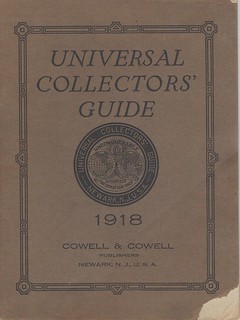 Collecting is not some new fad. People (not all people, mind you) have been collecting just about forever. Some quirk of human nature gives some of us the collecting bug for whatever objects interest us. While looking through my ephemera collection recently (see my Numismatic Diary in this issue for more), I came across the Universal Collectors Guide, a publication from 1918: "An Annual Publication Issued in the Interest of the Man, Woman or Child With a Hobby."
Collecting is not some new fad. People (not all people, mind you) have been collecting just about forever. Some quirk of human nature gives some of us the collecting bug for whatever objects interest us. While looking through my ephemera collection recently (see my Numismatic Diary in this issue for more), I came across the Universal Collectors Guide, a publication from 1918: "An Annual Publication Issued in the Interest of the Man, Woman or Child With a Hobby."
Pages 8 and 9 enumerate a set of 141 collecting categories; the remainder of the book is an alphabetical listing of collector names and addresses followed by the code(s) for items they collect. #1331 is Charles Quattlander of Brooklyn, NY whose code is "D-100" meaning he is a Dealer in Stamps. "B" indicates a Buyer, an "A" is a collector who neither buys nor sells; "X" is one willing to exchange or trade. Here are some of the catagories:
1: Animals - Stuffed
2: Antique Furniture
3: Arrowheads
26: Match Boxes
46: Relics - Indian
49: Sea Shells
71: License Tags - Automobiles
89: Sea Moss
112: Puzzles & Tricks
141: Insects - Trochoptera
Alas, no barf bags, hair clippings, bellybutton fluff or toenail clippings. However, in the numismatic vein there are several categories:
9: Broken Bank Notes
13: Coins - All Kinds
14: Confederate Money
27: Medals
33: Old Paper Money
63: Tokens - War and Hard Times
77: Coins - Copper
78: Coins - Gold
79: Coins - Silver
84: Numismatic Literature
85: Paper Money - All Kinds
117: Coins - Foreign
118: Coins - U.S.
120: Paper Money - Foreign
121: Paper Money - U.S.
#84 made me quite curious to learn who was buying and collecting numismatic literature in 1918. But random checks thru the book failed to find any names with a #84 following their listing. Hopefully there is at least one such listing somewhere in the book. I was hoping to find a digitized version online so I could do an electronic search, but no luck. A fun "someday" project, I guess. Does anyone else have a copy of this little book in their library? -Editor
To read the complete article, see:
43 People Who Collect The Weirdest Things Ever
(http://www.atchuup.com/weirdest-collection-of-things-ever/)
LOOSE CHANGE: JUNE 7, 2020
Here are some additional items in the media this week that may be of interest. -Editor
Book Review: Rivalling Rome
Over on the Coin Talk discussion board, member Parthicus posted a great review of the new book Rivalling Rome: Parthian Coins & Culture. Follow the link to see the complete review. -Editor
 This slim volume (118 pages) is intended to accompany a special exhibit at the British Museum, which was scheduled to run from April 2nd to September 6th, 2020. For obvious reasons (note to posterity: the COVID-19 pandemic) the exhibit has been postponed (the British Museum website says only that it is "coming soon") but meanwhile we are able to enjoy this book. Firstly, I will summarize that I found this book very enjoyable to read, and a useful overview of Parthian coins, history, and civilization. While I have a few minor quibbles, the book as a whole is very worthwhile, and I would suggest anyone with an interest in Parthian coins and history should purchase it.
This slim volume (118 pages) is intended to accompany a special exhibit at the British Museum, which was scheduled to run from April 2nd to September 6th, 2020. For obvious reasons (note to posterity: the COVID-19 pandemic) the exhibit has been postponed (the British Museum website says only that it is "coming soon") but meanwhile we are able to enjoy this book. Firstly, I will summarize that I found this book very enjoyable to read, and a useful overview of Parthian coins, history, and civilization. While I have a few minor quibbles, the book as a whole is very worthwhile, and I would suggest anyone with an interest in Parthian coins and history should purchase it.
While the book does include many clear photos of Parthian and related coins, it is not a comprehensive catalogue or identification guide (and is certainly not intended as such). Rather, the coins are used to illustrate both the history of the Parthian kings, but more importantly, examined for what they reveal about the Parthians themselves, particularly their cultural practices and religious beliefs, as well as aspects of their material culture (i.e. clothing, tools, etc.). The photographs are of good quality, all coins are depicted life-sized or larger, and the various other objects are also beautifully photographed.
To read the complete article, see:
Book review: Rivalling Rome: Parthian Coins & Culture
(https://www.cointalk.com/threads/book-review-rivalling-rome-parthian-coins-culture.361020/)
To read the earlier E-Sylum article, see:
NEW BOOK: RIVALLING ROME: PARTHIAN COINS
(https://www.coinbooks.org/v23/esylum_v23n20a06.html)
Michael Matzke (1966-2020)
Ursula Kampmann published an article in CoinsWeekly about the late Michael Matzke, an expert in medieval numismatics and curator of the Basel Historical Museum. -Editor
To read the complete article, see:
Michael Matzke (1966-2020)
(https://coinsweekly.com/michael-matzke-1966-2020/)
The Golden Biscuit
Ron Guth's blog recalls the 1976 Whist Match, where Large Cent collectors compared their specimens to discover the best. -Editor
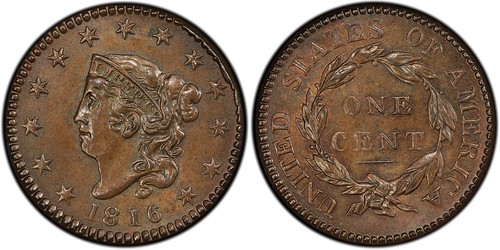
“Whist” predates the Set Registries by many years, but the basic premise of a Whist Match is that two collectors compare their coins to see who has the better collection. The benefit of a “manual” game of Whist is that outside parties can observe the contest, and that was where I found myself in 1976.
When the first 1816 variety, Newcomb 1, was called out, Doug placed his champion down on the felt pad – a coin he called “The Golden Biscuit.” That name stuck with me through all these years as one of the most significant remembrances from that meeting. In fact, that is all I remember of the 1976 Whist Match. I could not tell you who else was there, or about any of the other 1816 Cents, or even if Doug’s coin won (it’s listed as second finest in the Condition Census, so Ted probably beat it with the finest known). But that name – The Golden Biscuit – just stands out in my mind. Maybe I was hungry.
To read the complete article, see:
Coins and Memories
(https://numismaticdetectives.com/blog/f/coins-and-memories)
American Antiquarian Society Transcription
We're discussed transcription projects as a useful way to spend some free time during the pandemic shutdown. The American Antiquarian Society in Worcester, Massachusetts described their latest transcription project in their blog on June 2, 2020. See the complete article online to learn about the mermaid and the woman who swallowed two bullets. -Editor
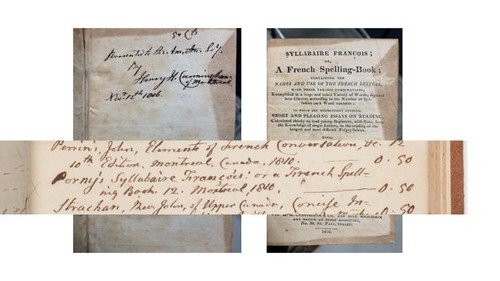
Staff at AAS have been sad and frustrated about Covid-19’s effects on our researchers, fellows, and fellow cultural institutions. Despite this hardship, we’ve been able to find some joy in our days and to feel connected to the collections we love by working on a staff-wide transcription of the first AAS donation book.
For those of you who are unfamiliar with the first donation book, it includes a list of all of the Society’s acquisitions between 1813 and 1829. Most of items in the list are written in our founder Isaiah Thomas’ own hand. It includes many artifacts from indigenous populations that were deaccessioned over the years, as well as all of the books, pamphlets, and manuscripts that we received during that period.
We started working on this project not long after we all began working virtually from home.
Two staff members transcribe each page of the donation book and, when the project is complete, we will reconcile the two transcriptions and produce one final, solid transcription. Once completed, we will post these transcriptions online. Digital images of the donation book are already available online here. Already 15 staff members have worked on the project, completing 120 pages from the donation book (that’s 240 pages of transcription!)
To read the complete article, see:
When Times are Tough, AAS Gets Going . . . on Transcription!
(https://pastispresent.org/2020/good-sources/when-times-are-tough-aas-gets-going-on-transcription/)
To read the earlier E-Sylum articles, see:
JOIN NATIONAL ARCHIVES TRANSCRIPTION INITIATIVE
(https://www.coinbooks.org/v23/esylum_v23n13a09.html)
NATIONAL ARCHIVES TRANSCRIPTION UPDATE
(https://www.coinbooks.org/v23/esylum_v23n14a20.html)
TRANSCRIPTION IS A BOOMING PANDEMIC ACTIVITY
(https://www.coinbooks.org/v23/esylum_v23n21a35.html)

